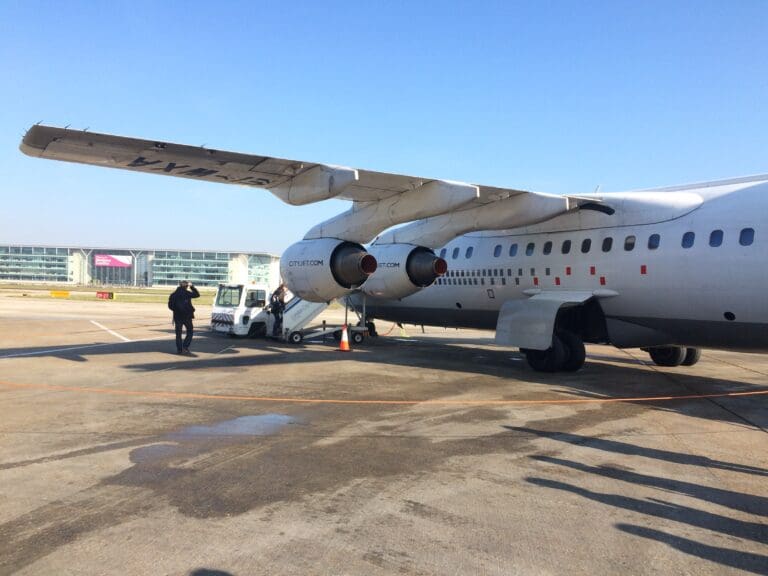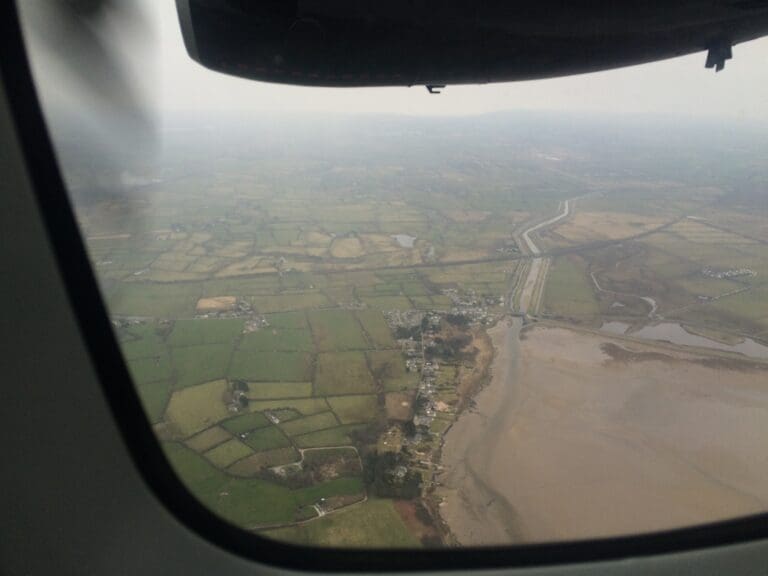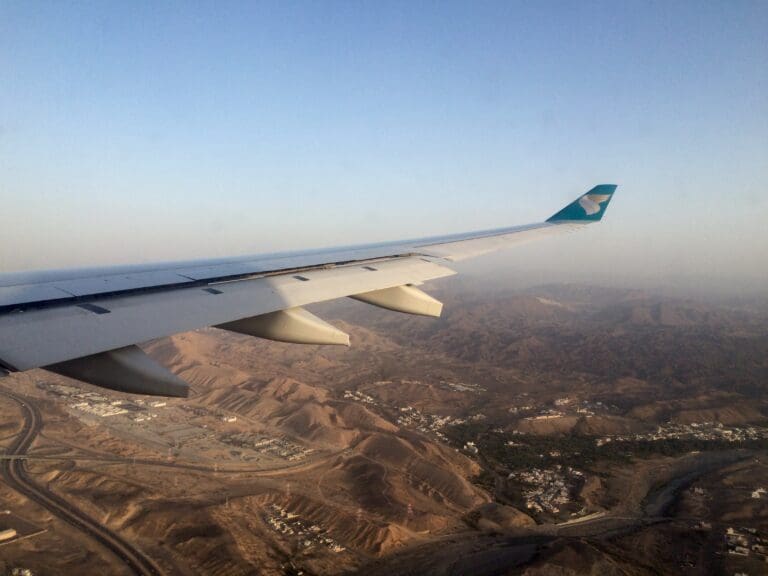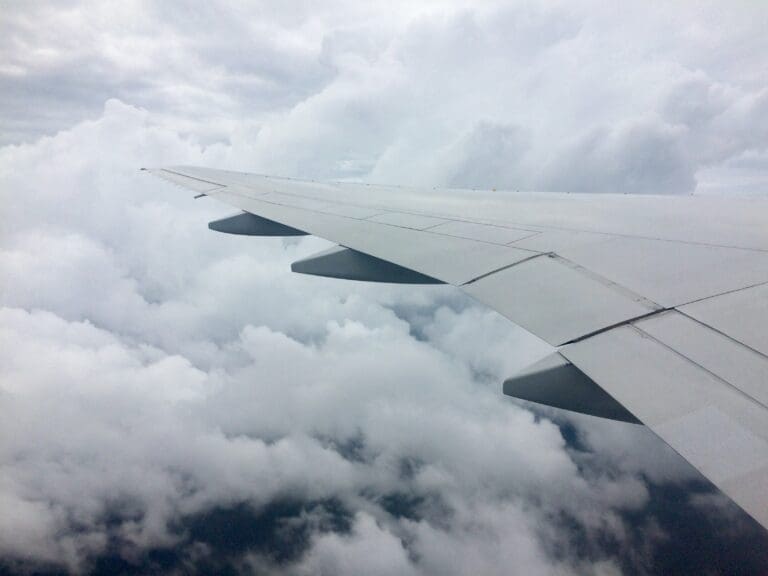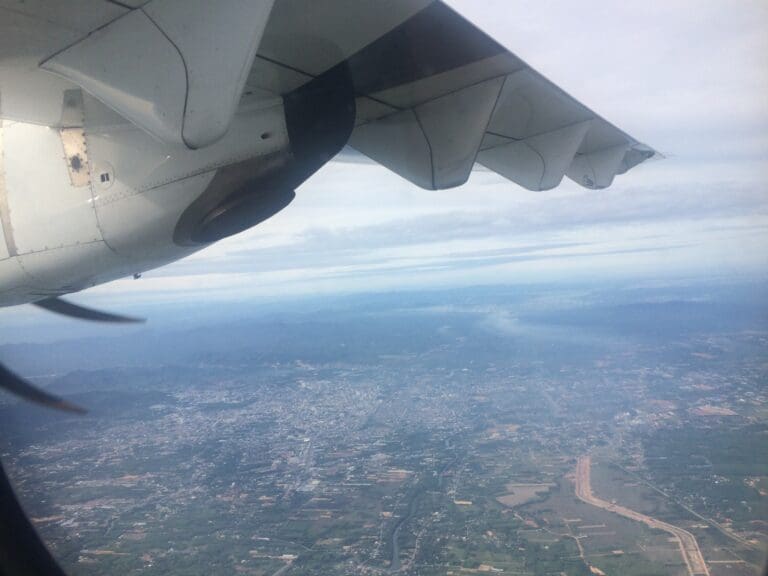Jet2 Review: Old but Gold – Flying to Switzerland on a Boeing 757
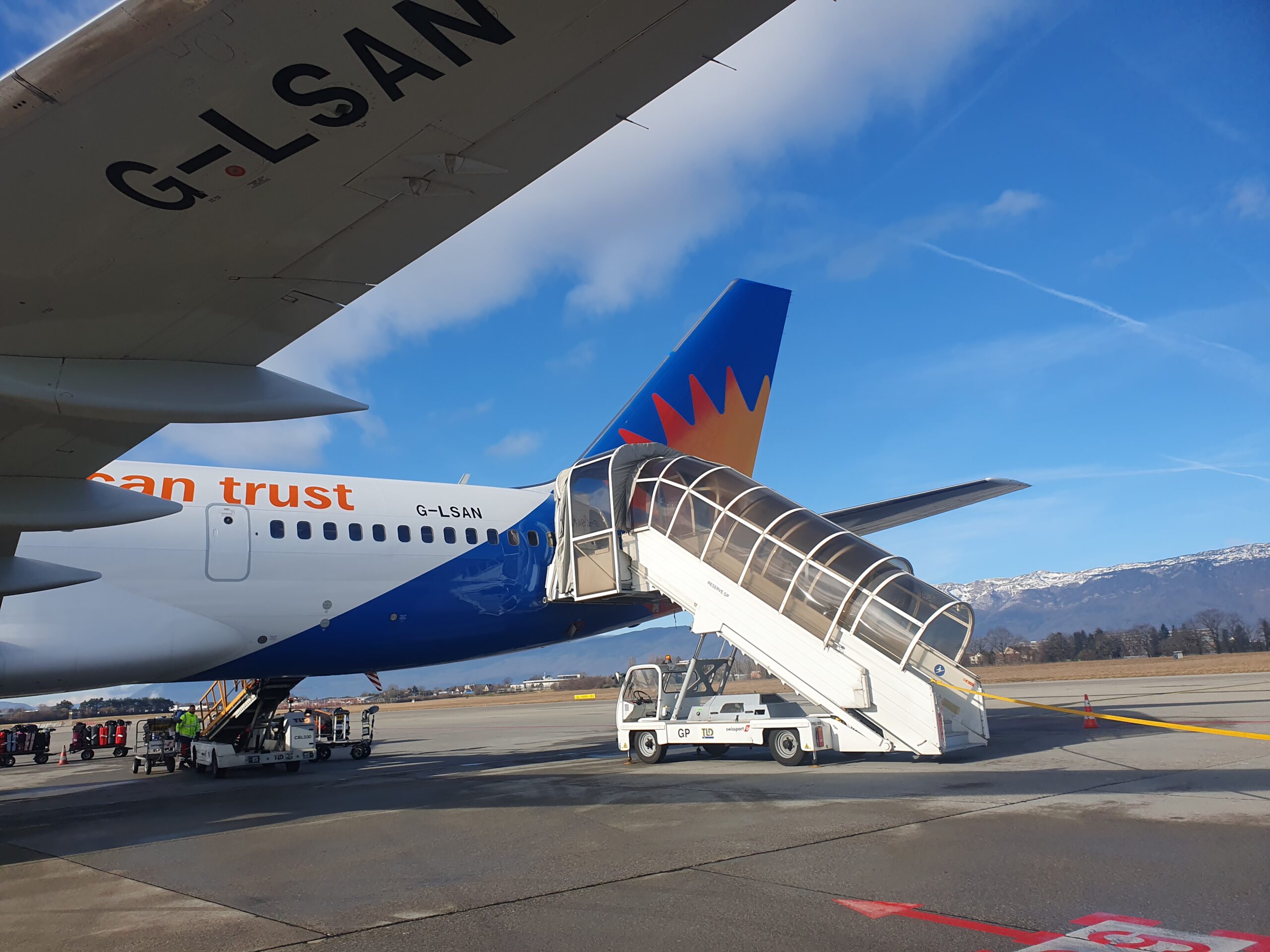
On the 11th of November 2024, one of Jet2’s few remaining Boeing 757s, G-LSAN, was flown from Manchester to St Athan Airport in South Wales to be parted out. This leaves just a small handful of Boeing 757s in Jet2’s fleet, the last of which is set to be retired in early January 2025. In commemoration of G-LSAN’s retirement, I have decided to post my review of a flight that I took onboard G-LSAN in February 2023 from Manchester to Geneva. This was written just after my flight onboard this aircraft and thus certain information may no longer be accurate or applicable.
Background
Once upon a not-too-distant time, the Boeing 757 was a common sight at airports across Europe with plenty of examples flying about operated by airlines from both near and far. However, as with several similarly aged types such as the Boeing 737 Classic and McDonnell Douglas MD-80, in recent years the number of Boeing 757s in service has dwindled. Today, just three European carriers outside of Russia operate the Boeing 757 on passenger services – leisure airlines Condor and Jet2, and Icelandic national carrier Icelandair. Living in the UK, for me, Jet2 provides the easiest and cheapest means of flying onboard this increasingly rare type.
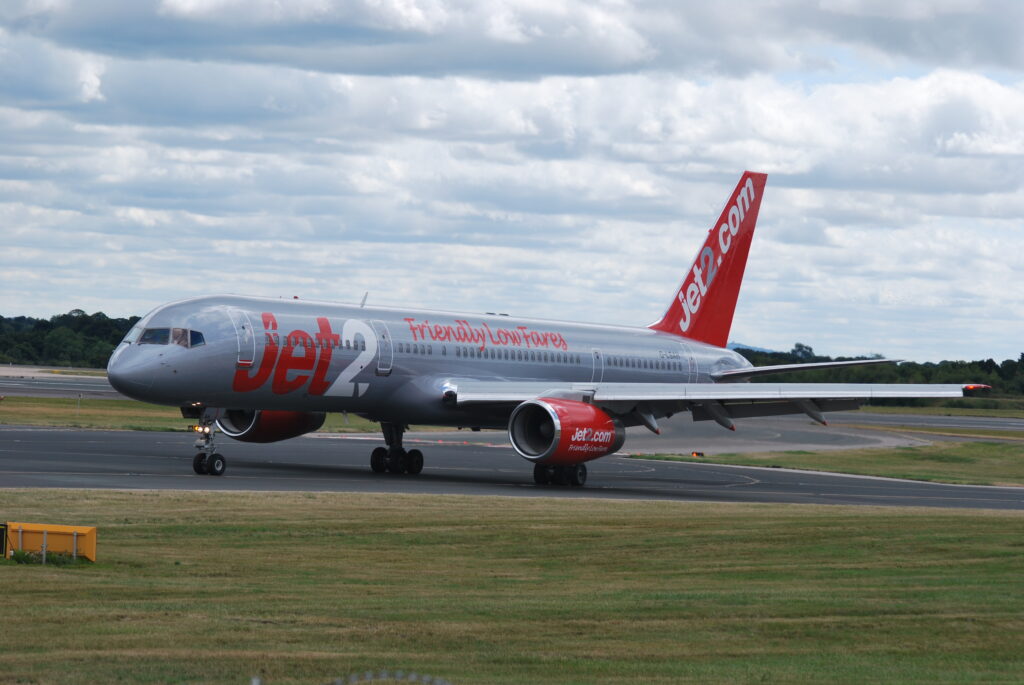
In the UK, Jet2 has become somewhat of a household name, enjoying status as Britain’s third-largest airline and as of February 2023, the airline operates services from ten airports across the UK to destinations across Europe. However, specialising in outbound holiday travel, abroad, Jet2 is arguably lesser known. Whilst Jet2 operated its first service in February 2003, the airline can trace its origins way back to the early 1970s and the formation of Douglas DC-3 operator, Carpenter’s Air Service. Specialising in the transportation of flowers, this shuttled between the Channel Islands and the UK, before rebranding as Express Air Services and then again as Channel Express in 1983. Continuing to transport cargo and having been awarded lucrative mail contracts, Channel Express operated a diverse selection of what would be considered to be very rare aircraft today – namely Fokker F27s, Handley Page Darts and Lockheed Electras. These were joined by a fleet of Airbus A300 freighters in the late 1990s before the carrier added its first Boeing 737 Quick Change aircraft in 2001, with the latter laying the foundations for the low-cost carrier. Despite being headquartered in Bournemouth, seeing a gap in the market, Jet2 opted to commence their passenger services from Leeds Bradford Airport. Since then, the airline has seen massive growth and today has its primary focus on its package holidays, although seats on most of the company’s flights can still be booked.
Looking to the future, Jet2 currently has a massive order for Airbus A320 and Airbus A321neos, although at present the vast majority of the airline’s fleet is made up of Boeing 737-800s. Much to the delight of aviation enthusiasts, the carrier is one of Europe’s last remaining passenger operators of the Boeing 737-300 and Boeing 757-200 aircraft, currently operating seven and eight of these respectively (as of February 2023). With all examples of the former type being based at Leeds Bradford, and all of the latter based at Manchester Airport. Focusing on the Boeing 757, as per Jet2’s winter 2022/23 schedule, these primarily plough the carrier’s long routes down to the Canary Islands in addition to the significantly shorter ski shuttle hop to Geneva and the rotation to Geneva. Needing to spend a week in Geneva for work, this proved to be a suitable opportunity to sample a ride onboard one of Jet2’s pencil jets and I was soon booked onboard Jet2’s early Sunday morning service down to Switzerland. With this scheduled to depart Manchester at 0655 and arrive in Geneva two hours later at 0955. Once booked, as with most low cost carriers I had the ability to add a variety of additional services to my booking such as seat selection, adding additional hold luggage and adding a meal, however in the end I opted against splurging out on these extras.
The Journey
Being Northern England’s largest airport, and the third busiest airport in the United Kingdom, Manchester Airport is reasonably connected to towns and cities throughout the region and beyond. This enjoys its own on-site train station, tram stop and bus station. Living in Leeds, the most obvious way to reach the airport would be to take a direct Transpennine Express service to Manchester Airport, with this taking around an hour and a half. However, given my crack of dawn 0655 departure, this was quite simply not an option unless I fancied splurging out on a night at an airport hotel. Fortunately, I did come across a direct National Express coach which would depart at 2310 on Saturday night and see me arrive at Manchester Airport at 0050. Granted, I would be in for the best part of an uncomfortable night in the terminal, however, costing just £7, this was far cheaper than splurging out on an airport hotel!
Soon, my departure day rolled around and I spent the first half of the weekend packing everything that I would need for my week in Geneva. Once I had bundled everything up into my small suitcase and backpack, I walked the short distance over to Leeds Coach Station, arriving there with fifteen minutes to go until the coach, which was bound for Liverpool, was scheduled to depart. Fortunately, with this commencing its journey in Leeds, this could already be seen, as could a gaggle of passengers, most of whom were armed with large suitcases.
After milling about for a while, passengers were eventually permitted to board and after the rather cool and stern-looking driver took my suitcase and scanned my ticket, I made my way onto the modern coach. Once upon a time, I had been a regular onboard National Express services, having spent around four hours at a time on them as I travelled between London where I attended university and my hometown, Sheffield. However, enjoying the luxury of not being a totally cash-strapped student, these days I prefer to take the train where possible. Nevertheless, once onboard and seated, I found the coach to be clean and relatively comfortable, whilst all seats were fitted with working plug sockets. For entertainment, National Express’ complimentary wifi worked reasonably well although since my last trip, the company’s VUER streaming service appears to have been discontinued.
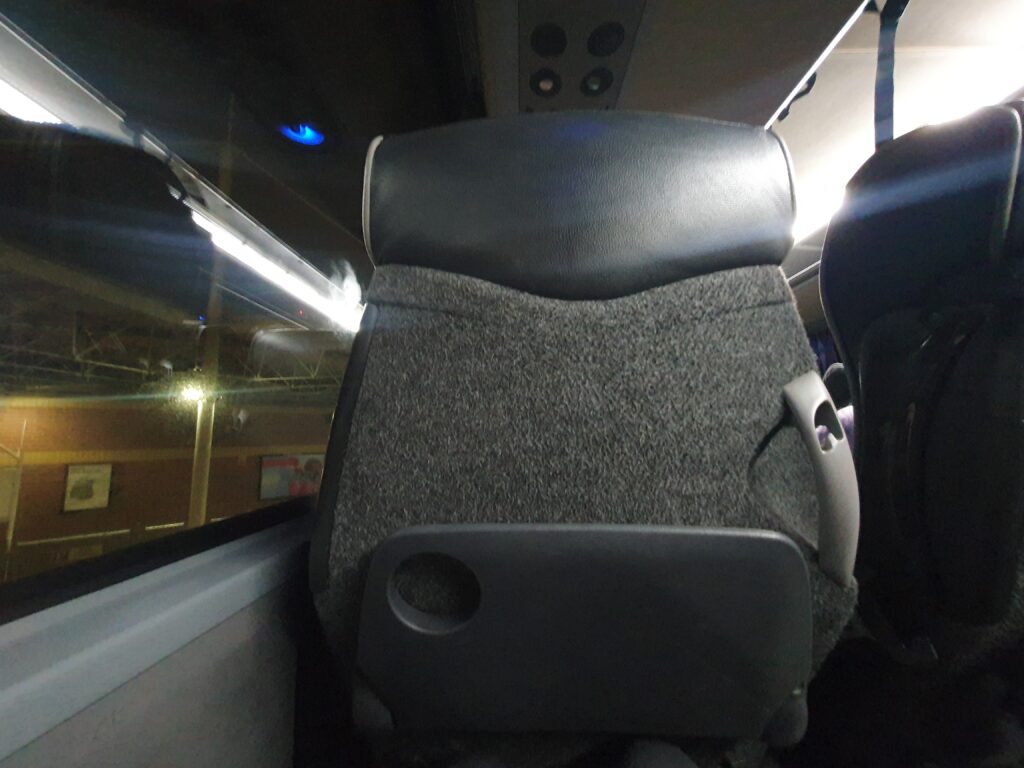
With passengers taking forever to board and get settled, it wasn’t until 2325 that the coach finally pulled out of the coach station and hit the relatively quiet streets just outside the city centre. Speeding out of the city, the bus soon joined the stream of lorries on the motorway as we headed westwards across the dark Pennines on the M62 motorway. Despite the occasional patch of roadworks, once on the motorway, the bus made good progress, encountering no jams whatsoever. Before I knew it, the bus left the M62 and wound its way through the suburbs of Manchester before arriving at the city centre bus station. With it being around 0030 on a Saturday night, several fairly messy scenes could be seen as revellers stumbled around on their way home or to the next pub! Following a short stop, we continued heading southwards and eventually at around 0100, the bus pulled into Manchester Airport Bus Station. Perhaps unsurprisingly, many passengers piled off the bus at this stop and following a short wait, I piled off, retrieved my small suitcase and made my way into the terminal to commence my night-long stay.
At the time of my trip, Jet2 operated a split operation at Manchester Airport. Whilst most of the airline’s flights departed from their hub in Terminal 2, a few Jet2 services departed from the slightly less glamorous Terminal 3. Fortunately, with Jet2’s services to Geneva departing from Terminal 2, I would get to experience Manchester Airport’s newly renovated terminal. Thus, once inside, I followed signs for Terminal 2 and walked along Skylink tubes, which were heavily lit by strong blue lighting. Unfortunately, these passageways are locally famous for their static moving walkways that appear to have been undergoing maintenance for years! Trundling along with my small suitcase in tow, it took about five minutes before I reached Terminal 2’s large check-in hall. It had been almost three years to the day since I had last made my way through Terminal 2, and since my last trip through this, work to modernise the landside portion of the terminal was well and truly underway. Looking around, approximately half of the terminal appeared to be bright and modern, whilst the other seemed to be straight out of the 1990s.
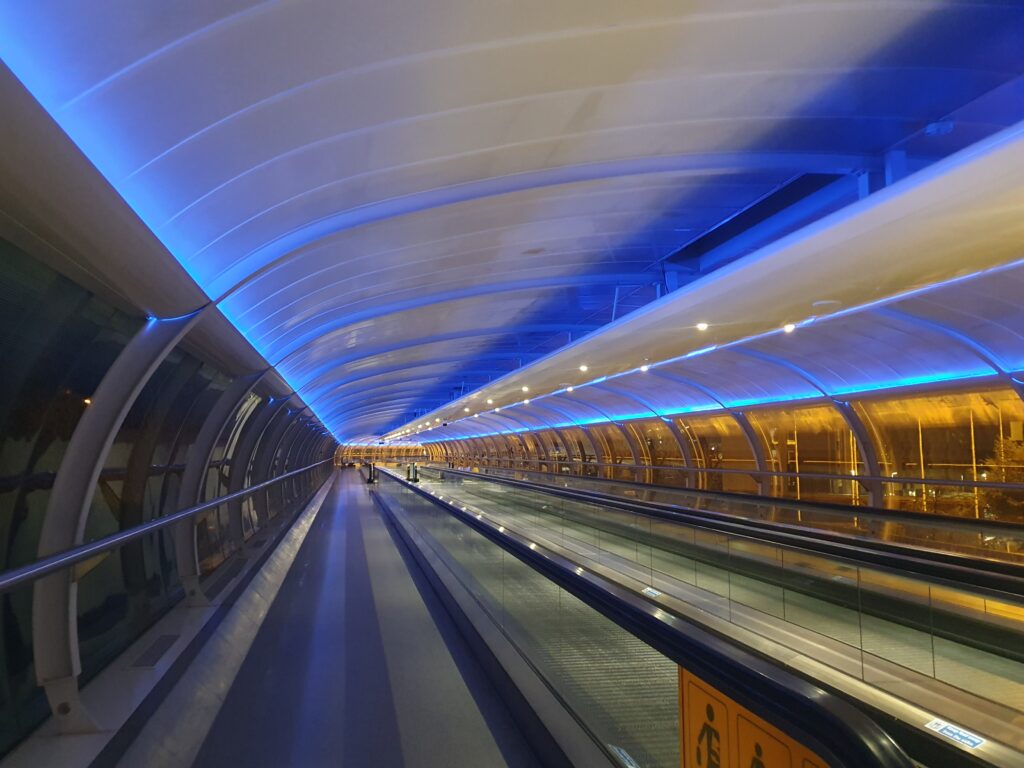
Alongside Jet2, both TUI and Virgin Atlantic’s Manchester operations are centred on Terminal 2, however, it was fair to say that Jet2 had invested the most in their branding in the terminal. Inside, Jet2’s check-in space was unmissable, being completely decked out with the airline’s red branding and signs, and complete with self check-in machines, automated bag drop-off desks and more traditional manned check-in counters. However, unsurprisingly, upon arriving in the check-in hall, Jet2’s check-in zone was closed, so I had no option but to settle down for the night. Unfortunately, with bright lights beaming down and a limited number of benches, Terminal 2 is far from a comfortable place to stay, and I momentarily pondered the thought of heading to the nearby Ibis, Holiday Inn or Radisson to enquire about a room for a few hours. However, I decided to power through and had a wander around. Heading down the escalators, I found the arrivals area to be a bit more lively, with a stream of passengers filtering through from holiday flights arriving from the Canaries and Turkey, alongside open branches of Pret a Manger and Starbucks, and an M&S Simply Food.
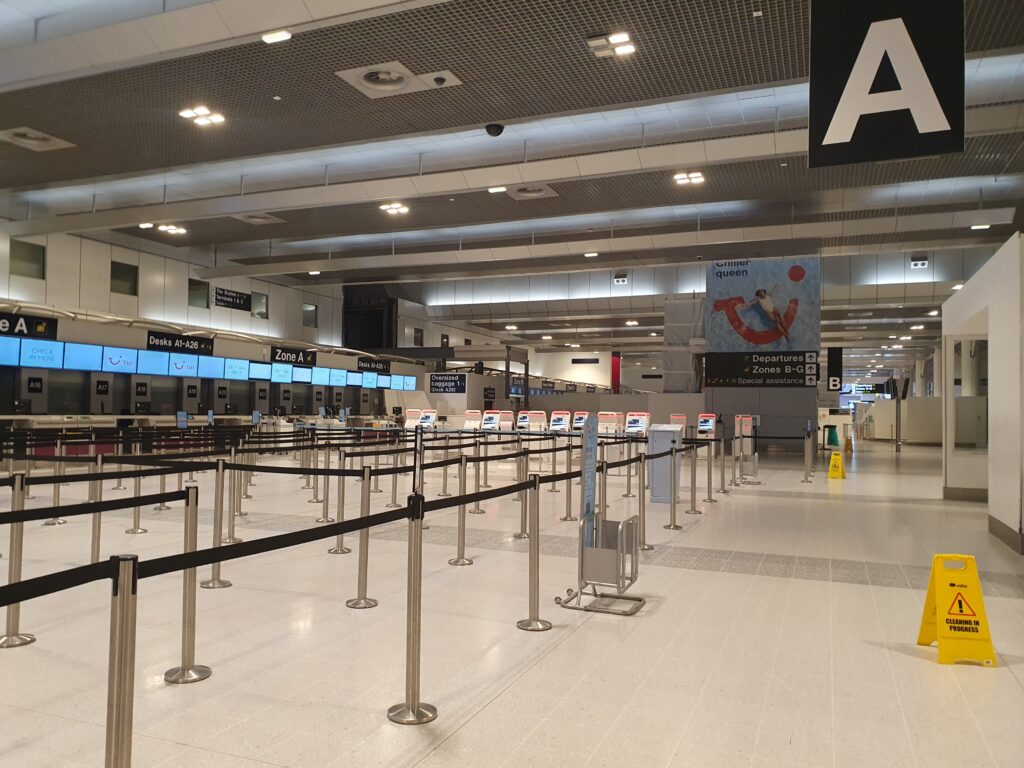

Eventually, I made my way back up to the check-in hall. With plenty of weary passengers scattered about, it took some wandering around before I was finally able to find a seat to sit and wait. After two sleepless hours during which I passed the time by watching some television, at about 0300, an army of Jet2 agents dressed in their distinctive red uniforms appeared and began to ready the check-in area in preparation for a new day of operations. That morning, there would be a total of sixteen Jet2 services departing from the terminal, and had I not wished to jet to Geneva I could have instead gone to the likes of Arrecife, Alicante, Antalya, Barcelona, Chambery, Fuerteventura, Gran Canaria, Grenoble, Innsbruck, Kitilla, Malaga, Paphos, Tenerife South or Turin. Whilst it may seem as if Jet2 rule the roost at Terminal 2, that morning plenty of services operated by other airlines could be seen on the departure boards – namely Aer Lingus, Air France, Etihad Airways, KLM, Kuwait Airways, Pegasus and Singapore Airlines.
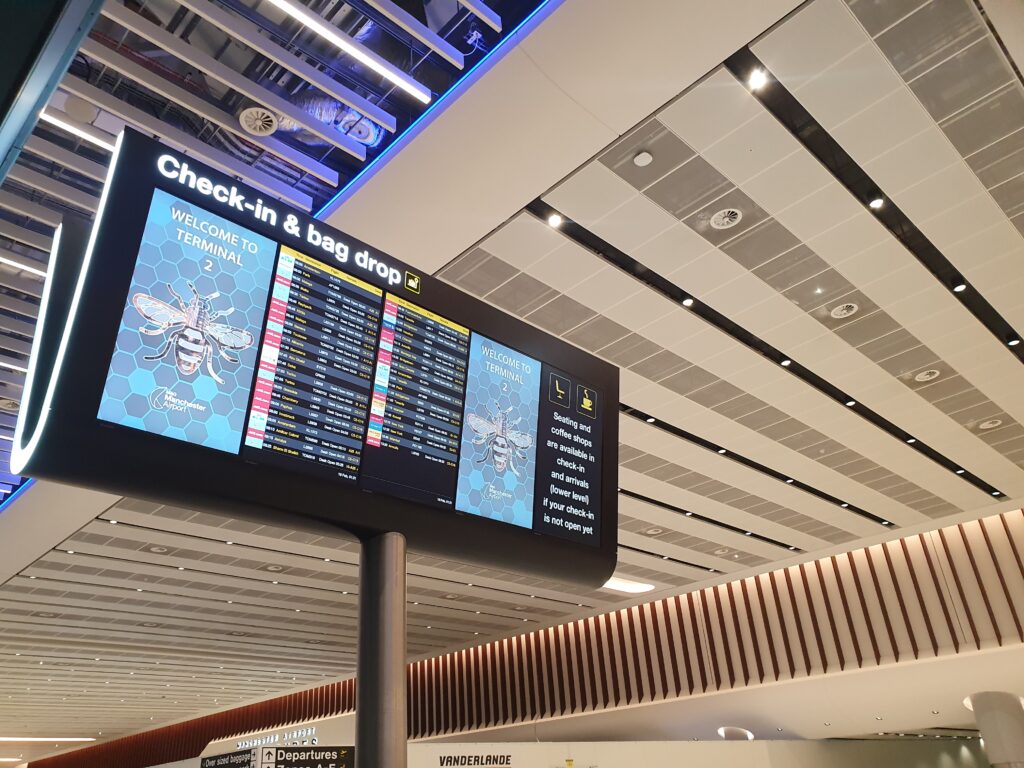
Having spotted an army of Jet2’s ‘red team’ donned, as their name would suggest, in distinctive bright red uniforms, descend upon the airline’s check-in area, a little after 0300 I decided to try my luck and attempt to check-in for my flight to Geneva. As soon as I approached the airline’s check-in area, I received a very warm and perhaps overly lively greeting (considering the very early hour!) from one of the ground staff who asked me for my destination. Once I had replied Geneva, another staff member escorted me over to a self check-in machine in order for me to bring off my boarding pass and baggage tag. In what was a rather nice touch, the agent guided me through the entire process and made conversation with me regarding my upcoming trip before escorting me over to one of the automated bag drop-off desks and wishing me a lovely flight. All in all, this definitely the best check-in experience that I have perhaps ever encountered and I could not fault Jet2 at that stage in any way, shape or form. On a side note, Jet2 offers twilight check-in at their bases and a number of overseas airports, and I could have dropped off by bag between 1600 and 2100 on the day before my flight. Although not living locally nor overnighting in an airport hotel, this would not have been of much use to me.
With Manchester Airport having gained an unfortunate reputation for long security queues during the Covid era, I was a little apprehensive about facing a long wait although being one of the first passengers of the day to arrive there, I was pleased to find security to be reasonably quiet and I was able to sail through within a few minutes. Not only this, but I found the staff members working there to be friendly, helpful and welcoming. With this being my first time passing through the terminal Since the first stage of its improvement works had been completed, I was eager to see how the airside area had changed since 2020.
Given the upgrade works that had taken place since my last trip through the terminal, that morning I had somewhat high expectations for the airside area and was looking forward to wandering around the terminal. Upon reaching the main airside hub I found this to be bright and modern. Adding a nice local touch, plenty of bee-themed designs could be spotted throughout, explained by the fact that the worker bee has been a symbol of Manchester since the Victorian era. In terms of the terminal’s layout, its gates are spread across three different areas – a newer longer pier that opened in 2021 and is a fair walk away from the main airside waiting area, bus boarding gates and a row of gates in the dated unrefurbished part of the terminal. Whilst I am sure that there is a plan to make arrangements a little more straightforward once the upgrade works have been completed, rather annoyingly those heading to the latter two pairs of gates must backtrack out of the main airside waiting area and past security, and to be honest I didn’t think these two areas were particularly well signposted.

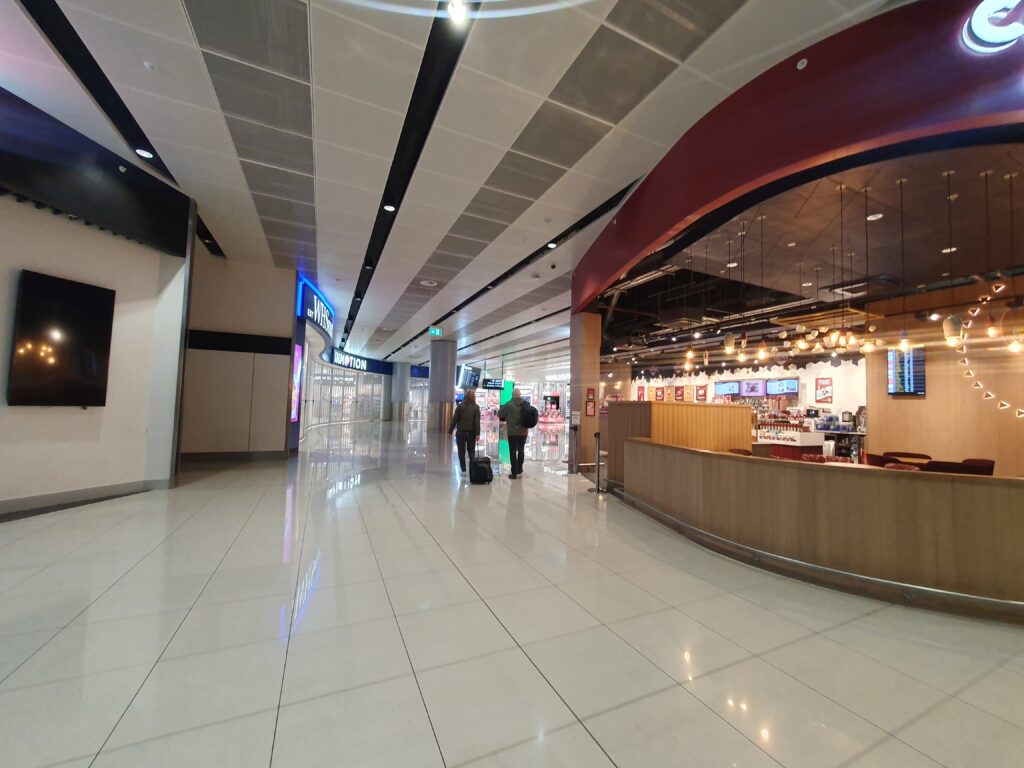
Being one of Britain’s major terminals, once airside, this contained all the facilities you would expect to find such as a selection of cafés, bars and shops. However, despite its somewhat unique design, I didn’t find there to be all too much about the terminal was was particularly out of the ordinary. Starting with the positives, much of this was clean and tidy, plenty of seating was dotted about, the complimentary wifi worked without issue and plenty of plug sockets and USB-A ports could be found for those to charge their devices. Importantly, plenty of floor-to-ceiling windows could be found, which, when travelling during the day offer good views out onto many of the terminal’s stands as well as the remote stands located a short distance away from the terminal. However, all was not totally fantastic, as I found toilet facilities, especially in the main portion of the terminal to be both limited and rather dirty.
Returning to my journey, once airside, not feeling in the mood for breakfast, I decided to save this until I had touched down on Swiss soil and instead purchased an overpriced coffee from the local branch of Costa before settling down near one of the windows. Eventually, as time passed, the lights of a selection of aircraft began to appear outside as they arrived in Manchester following both short and long overnight slogs. These included locally based jets such as those of TUI Airways and Virgin Atlantic, alongside overseas guests provided courtesy of Cathay Pacific, Qatar Airways and Singapore Airlines. Meanwhile, with Manchester Airport serving as Jet2’s largest base, plenty of the airline’s Airbus A321s, Boeing 737-800s and Boeing 757-200s could be seen both at the terminal and remote stands. These featured both the airline’s ‘classic’ red and silver livery and the newer (and less popular!) Jet2Holidays blue and white colour scheme.
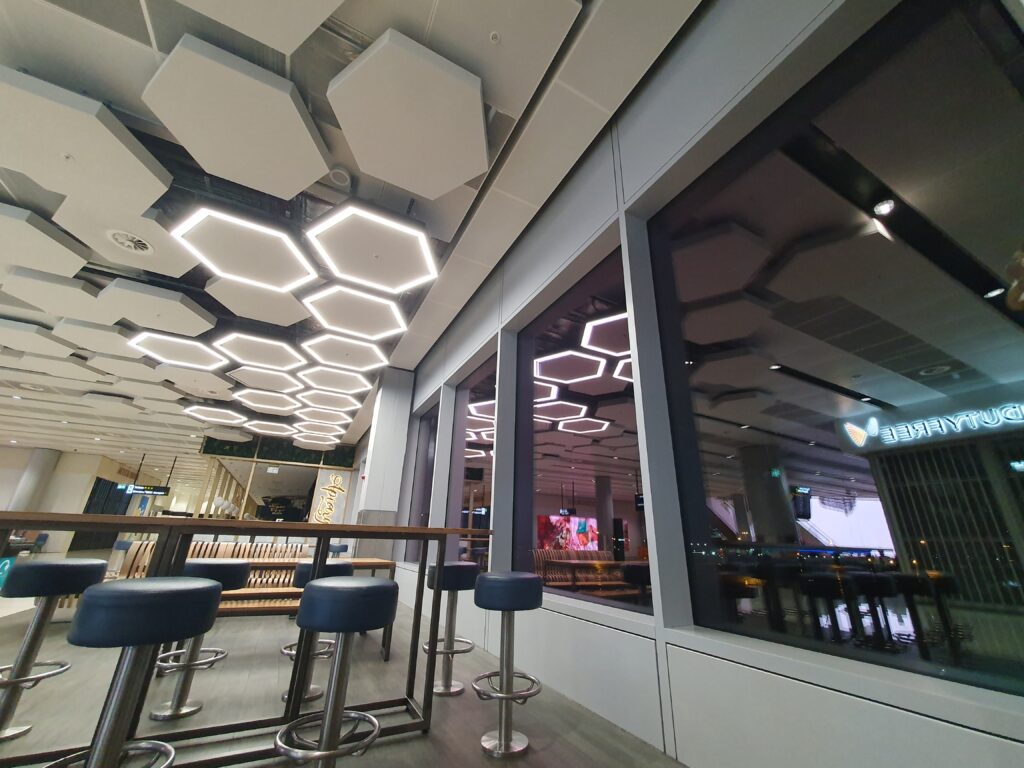
That morning, my ride to Geneva would be departing from Gate 204 near the terminal’s older and original pier. Following a slightly roundabout walk, I soon arrived in this part of the terminal which lacked any sort of facilities and was looking rather rundown. As is the case at most of their bases, Jet2 completely handles its own services at Manchester Airport, and thus once at the gate, three Jet2 staff members could be seen undertaking preparations for boarding. Meanwhile, a small yet growing cluster of passengers could be seen milling about and eager to head off.
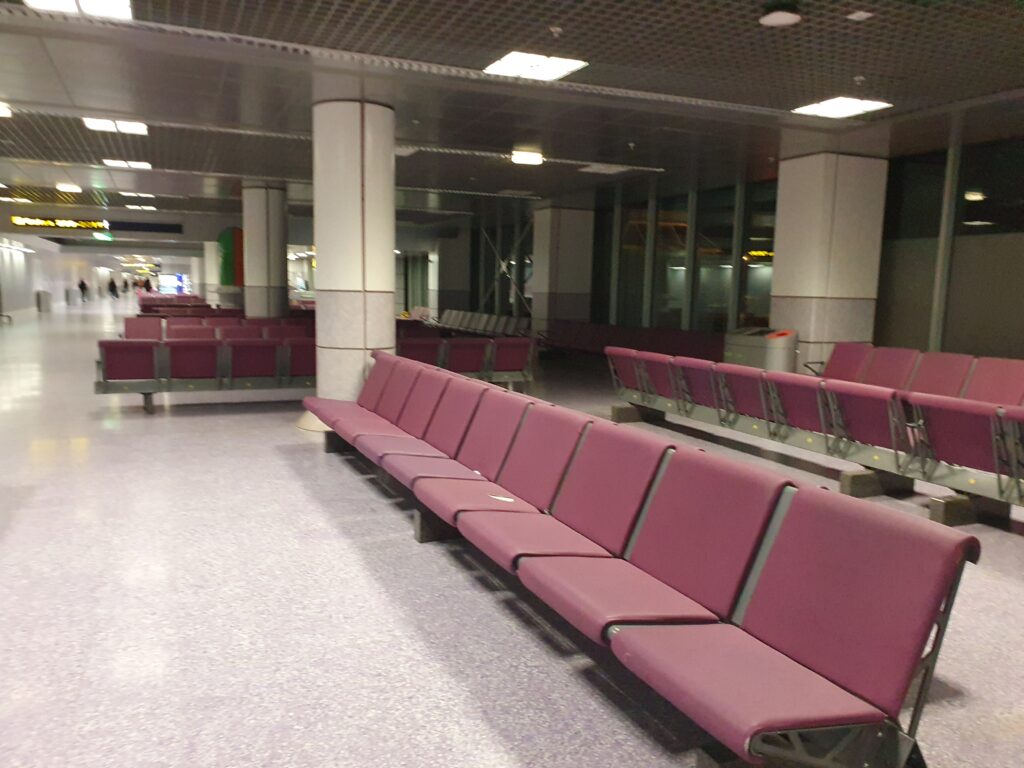
Looking through the windows, I soon spotted the Boeing 757 that would be taking us 618 miles southwards to Geneva that morning basking in the glow of the apron floodlights. This particular aircraft came in the form of G-LSAN, a Boeing 757-2K2. With the line number of 608, this aircraft took to the skies of Washington State for the first time in March 1994 and was thus a little under 28.9 years old at the time of my flight. Believe it or not, this meant that the aircraft was one of the younger Boeing 757s in Jet2’s fleet at the time, with the oldest having taken to the skies in 1987!
In April 1994, this aircraft was shuttled across the Atlantic and began its commercial life based at Amsterdam Schiphol where it operated for Dutch leisure airline Transavia Airlines as PH-TKC. Several years later in 1997, the aircraft experienced a rather notable accident when the landing gear collapsed upon landing in Amsterdam from Las Palmas. Fortunately, the aircraft was eventually repaired and re-entered service, remaining with Transavia Airlines until November 2003 when the airline retired its remaining Boeing 757s and transitioned to an all Boeing 737NG fleet. Still being a reasonably new jet, this soon found a new home in Indianapolis with ATA Airlines as N512TZ. However, the jet’s American career did not last too long and in early 2005 the jet was ferried to Southend in Southern England and repainted into the colours of French charter specialist Axis Airways and given the registration F-HAXY.
After a stint based in Paris CDG, the Boeing headed across the Atlantic for a new life in South America and joined the fleet of Avianca’s Brazilian arm, Oceanair, as PR-ONF in December 2007. However, after less than a year of being based in Brazil, in October 2008 the aircraft was transferred to Avianca Airlines and re-registered N635AV. Soon enough, it was time for another move and in March 2010, the aircraft found a new home in Ecuador where it was registered HC-CIY and joined the fleet of AeroGal, who had just announced their merger with Aviana Airlines. Named ‘Solitario George’ after the Galápagos Islands’ famous tortoise, this aircraft operated in the skies of Ecuador until 2012 when it was ferried back across the Atlantic to Norwich where it was repainted into the blue and white colours of Jet2Holidays. Since then, the aircraft has ferried holidaymakers across Europe and, like all of Jet2’s Boeing 757-200s, is now based at Manchester. With Jet2’s operations swelling during the summer season, it didn’t come as much of a surprise to find that this particular Boeing had spent much of the previous week on the ground at its base in Manchester, having flown just two rotations from Manchester to Tenerife South in the days leading up to my flight.
With 45 minutes to go until departure, the gate staff performed a lively announcement wishing everyone a lovely holiday and inviting passengers to board the aircraft. Looking around, there definitely did not appear to be enough passengers to fill all 235 seats onboard the aircraft and I hoped that I would be in for a fairly quiet ride to Switzerland. Ending up near the front of the queue of passengers, I soon had my boarding pass scanned and my passport checked by another very friendly staff member before I was free to head down the viewless jetbridge towards the waiting Boeing 757.
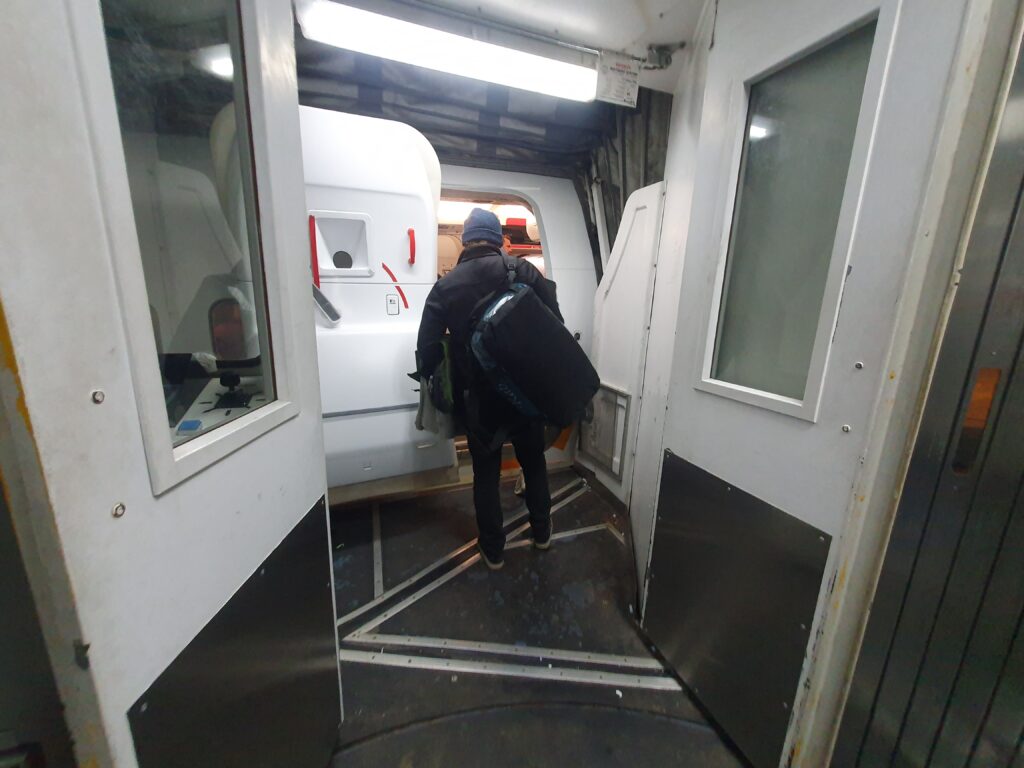
Following a short wait, I stepped into the aircraft via the L2 door and immediately entered the cabin where I was lively greeted by two of the five flight attendants onboard the aircraft that morning. Jet2 prides itself in its cabin standards and whilst this aircraft may have had a long career with a handful of airlines across the Western Hemisphere, inside this is very much a Jet2 jet, with the red bulkhead walls featuring Jet2’s logo, customised overhead lockers with red handles and trimmings, and decals that advertise the airline’s destinations, and slimline Acro seats that are covered in either a red or silver pleather cover.
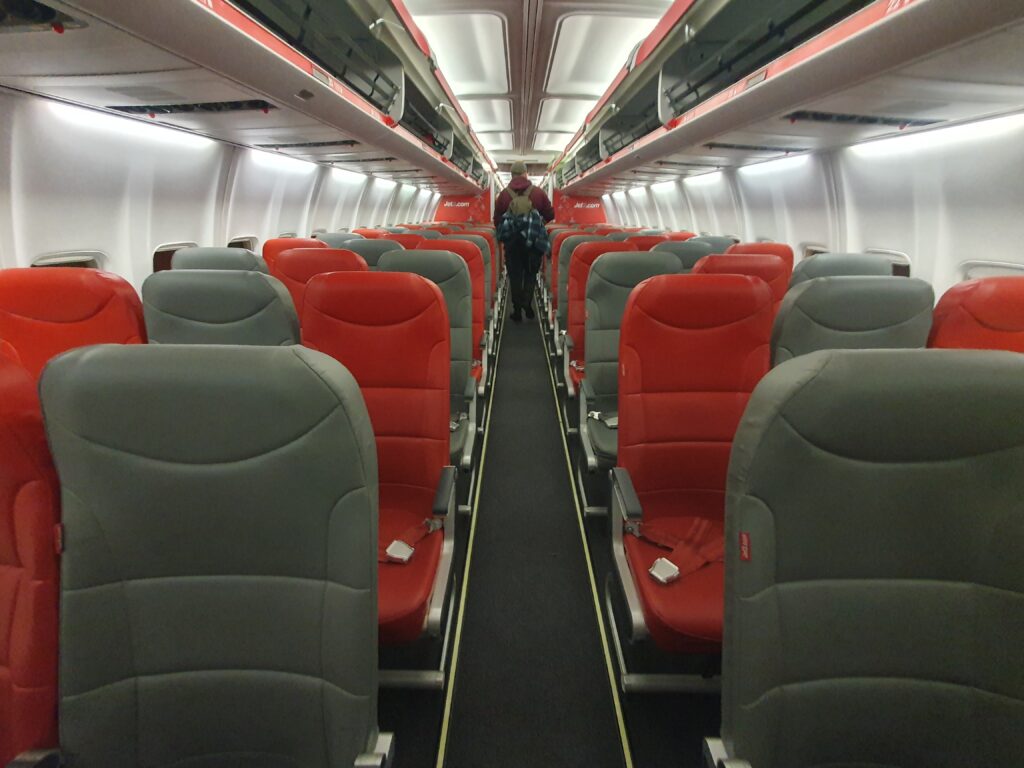
Once onboard, I turned right and made the short walk down to Seat 23F, located above the wing. After storing my bag in the overhead locker, I settled down for the fairly short flight ahead. Whilst thin, I was pleased to find the seat to be comfortable and offered a good amount of legroom. Despite the aircraft’s age the area around my seat appeared to be in a tip-top condition with virtually no signs of wear and tear, thereby masking the Boeing’s true age with ease. Importantly, the cabin appeared to have been cleaned to a high standard and I spotted no signs of dirt or rubbish onboard. Turning to the seat, whilst perfectly comfortable for a short haul flight, this is a little basic, with nothing other than a drinks holder, a small tray table and a seatback pocket on offer to passengers. Turning to the seatback pocket, this contained a safety card, the latest copy of Jet2’s monthly JetAway magazine, the Jet2Shop catalogue and a copy of the buy-on-board MMmenu.
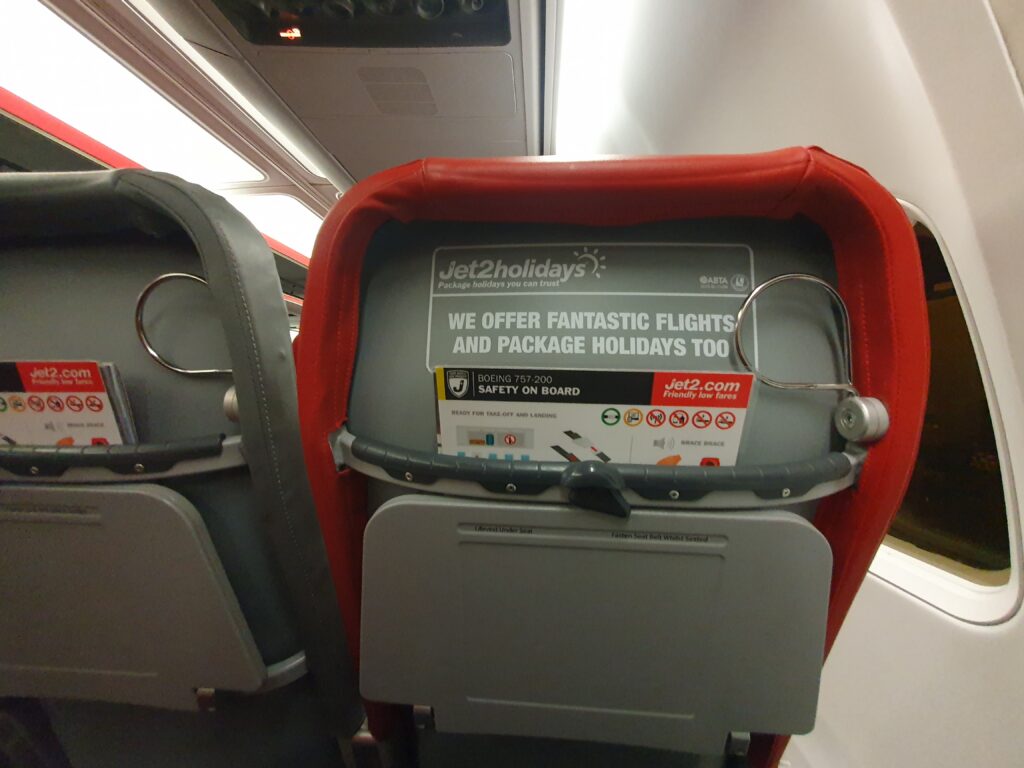
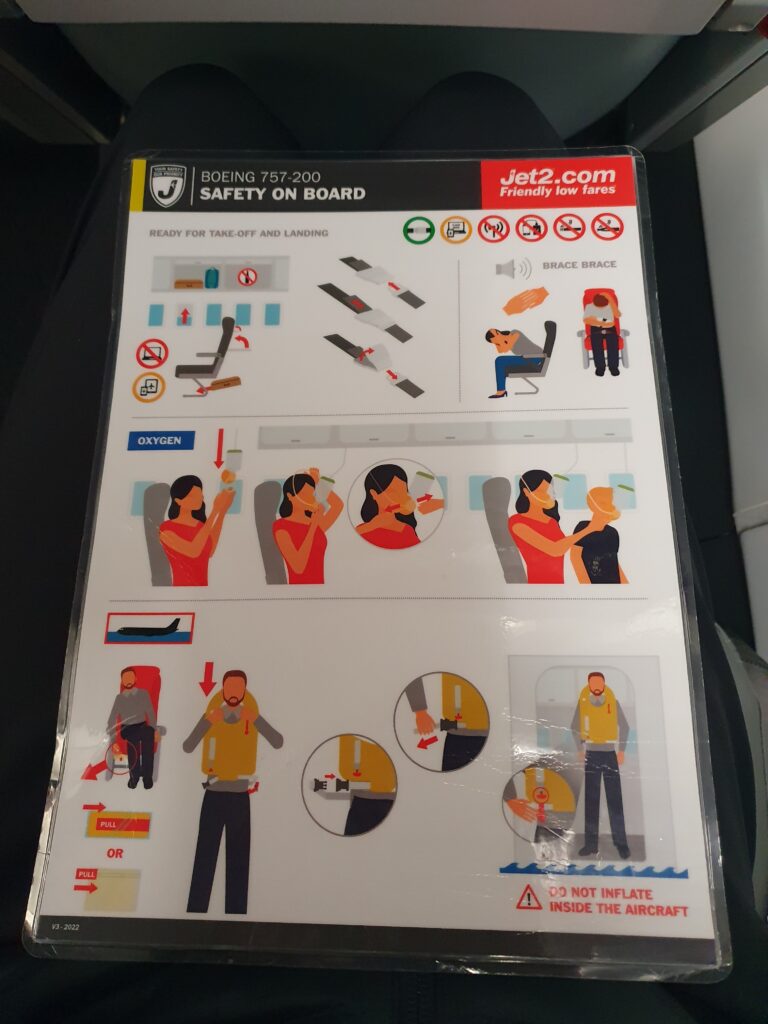
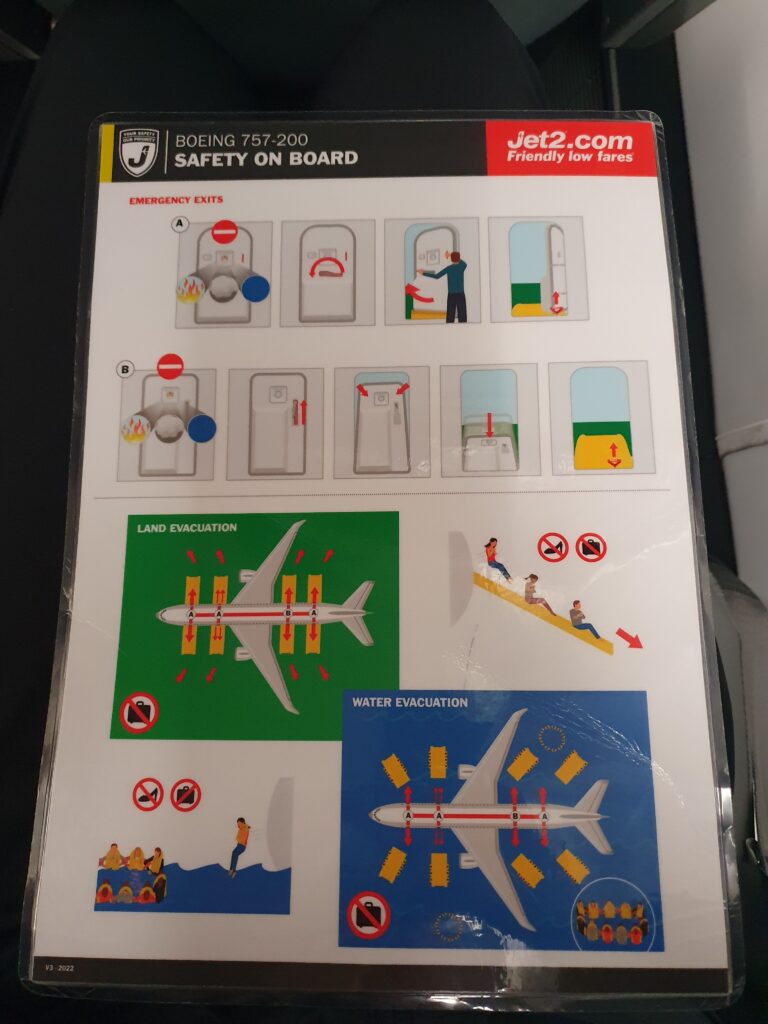
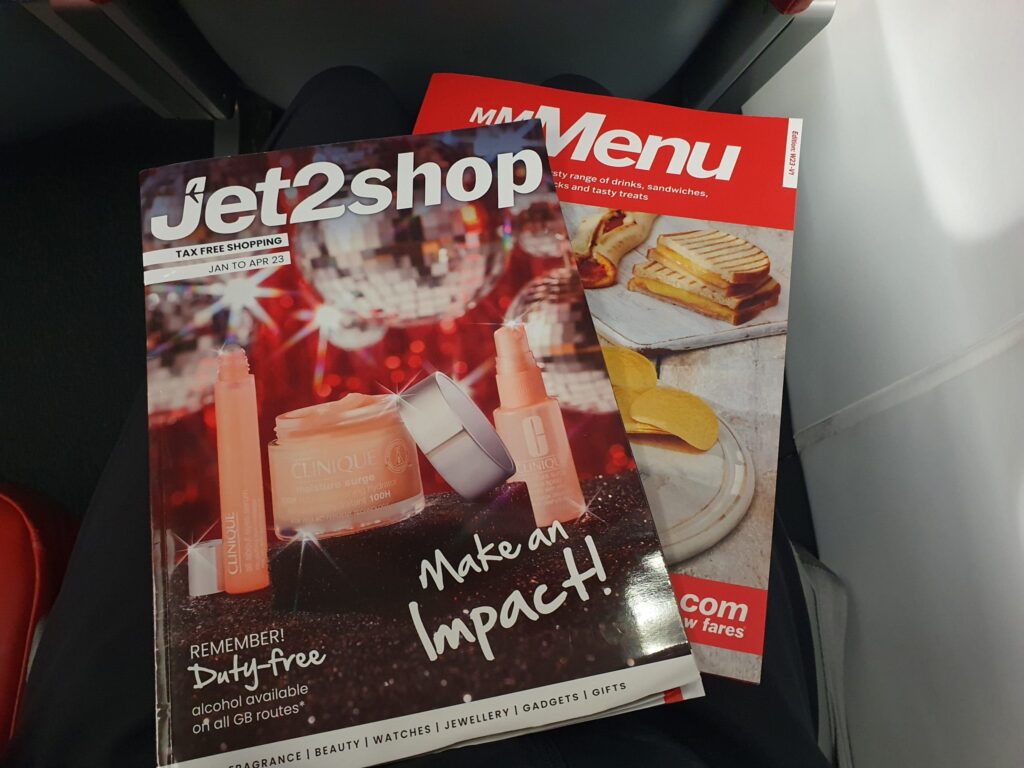
As passengers boarded the jet, the upbeat songs of the likes of Abba, Fleetwood Mac, Haim and S Club 7 amongst others provided a soundtrack to boarding, with this occasionally being interrupted by pre-recorded announcements detailing various things. Uncertain as to whether I would end up being trapped in, I decided to make a pre-departure visit to one of the lavatories. In total Jet2’s Boeing 757s are fitted with four lavatories – two at the front of the aircraft and two sandwiched sandwiched between the middle and rear cabins. This equates to a total of 59 passengers per toilet, slightly below the 63 passengers per toilet on Jet2’s Boeing 737-800 fleet. Like the rest of the aircraft, this had received its own unique Jet2 touch, with a snowboarder covering the wall behind the toilet – with holiday snaps visible behind the toilets on all Jet2 jets. Despite being a little dated in its design, this was clean and served its purpose, although I did notice a rather unpleasant stench lingering in this. Rather interestingly, the bin flap seemed to be an original, displaying ‘no cigarette disposal’ messages in Arabic, Dutch and Spanish, presumably from the aircraft’s time at Transavia Airlines!
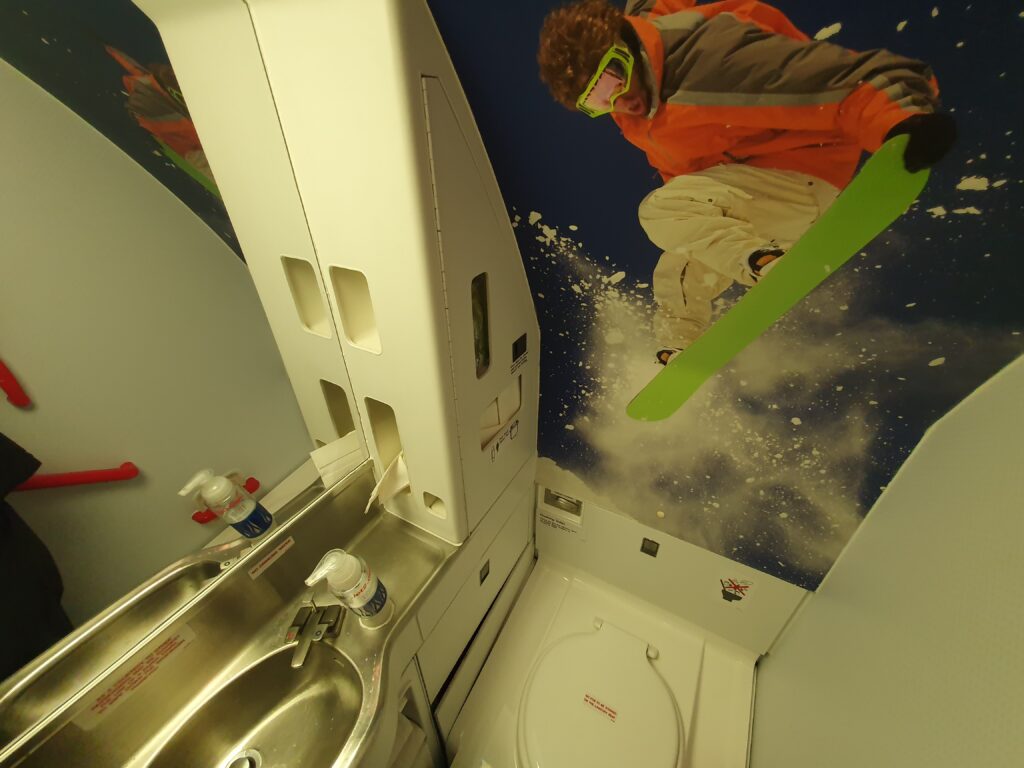

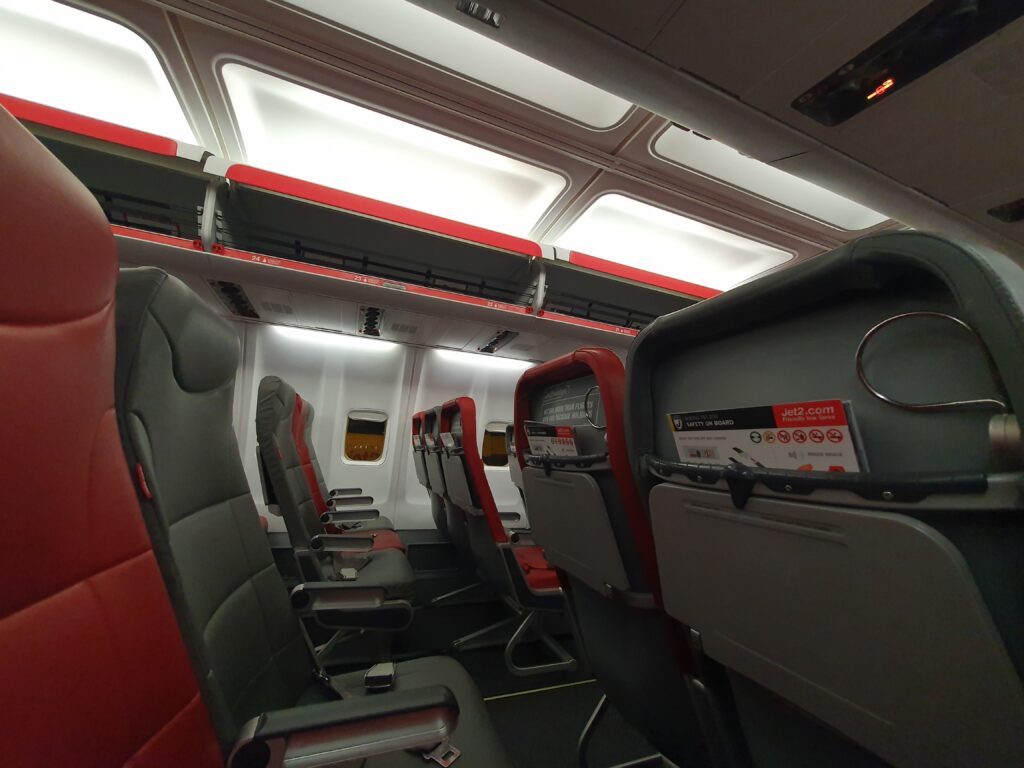
Once back in my seat, passengers continued to board whilst outside the skies slowly began to brighten, illuminating the TUI Airways Boeing 787-9 Dreamliner pulling into the neighbouring stand after an overnight slog from Cancun. That morning, passengers boarded in a quick and fuss-free manner, with the last passenger boarding around five minutes before our scheduled departure time. Once they had made it onto the jet, the door was closed and soon the Captain performed a detailed welcome announcement where they welcomed all onboard, thanked passengers for flying with Jet2, gave an overview of the route and weather in Geneva and advised passengers that we could expect to touch down in Switzerland on time. Much to my delight, both neighbouring seats remained vacant and I would thus be in for a spacious ride down to Geneva. Looking around, the aircraft seemed to be no more than about 60% full, and, as expected many of those around me seemed to be jetting off on late-season skiing holidays, making the most of the snow before things warmed up for spring.
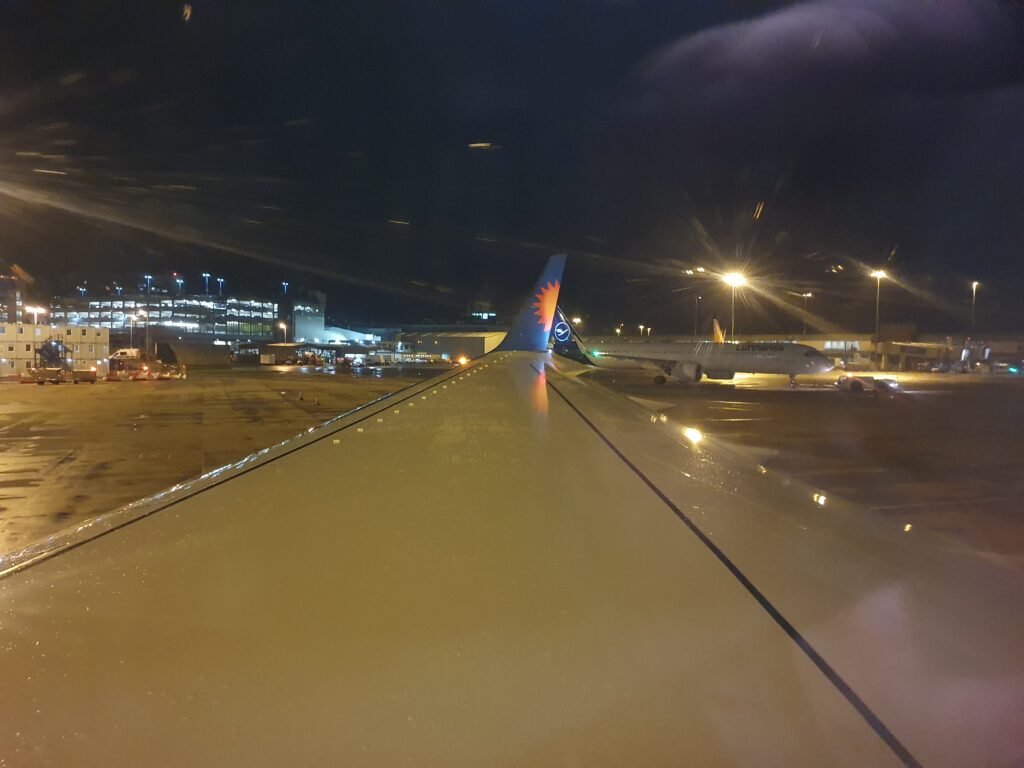
Once the Captain had performed their announcement, one of the flight attendants performed a lively welcome, which was soon followed by a safety demonstration. This was undertaken along to a pre-recorded soundtrack whilst several crew members undertook a demonstration in the aisles. Whilst this was underway, two minutes before our scheduled departure time, the Boeing jolted back and soon, the whines and whirs of the aircraft’s two mighty Rolls-Royce RB211-535E4 engines powered into life. As these neared the end of their start-up procedure, the crew passed through the cabin ensuring that all was secure and in place for our departure and after a few minutes, the Boeing commenced its journey to the end of Runway 23R.
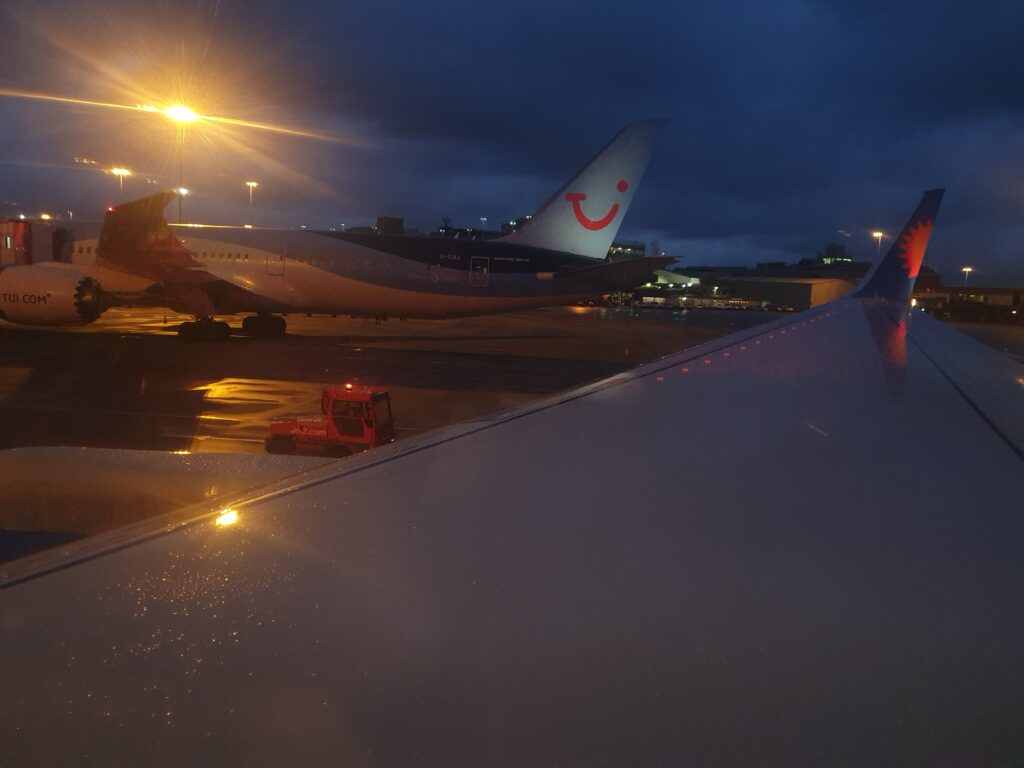
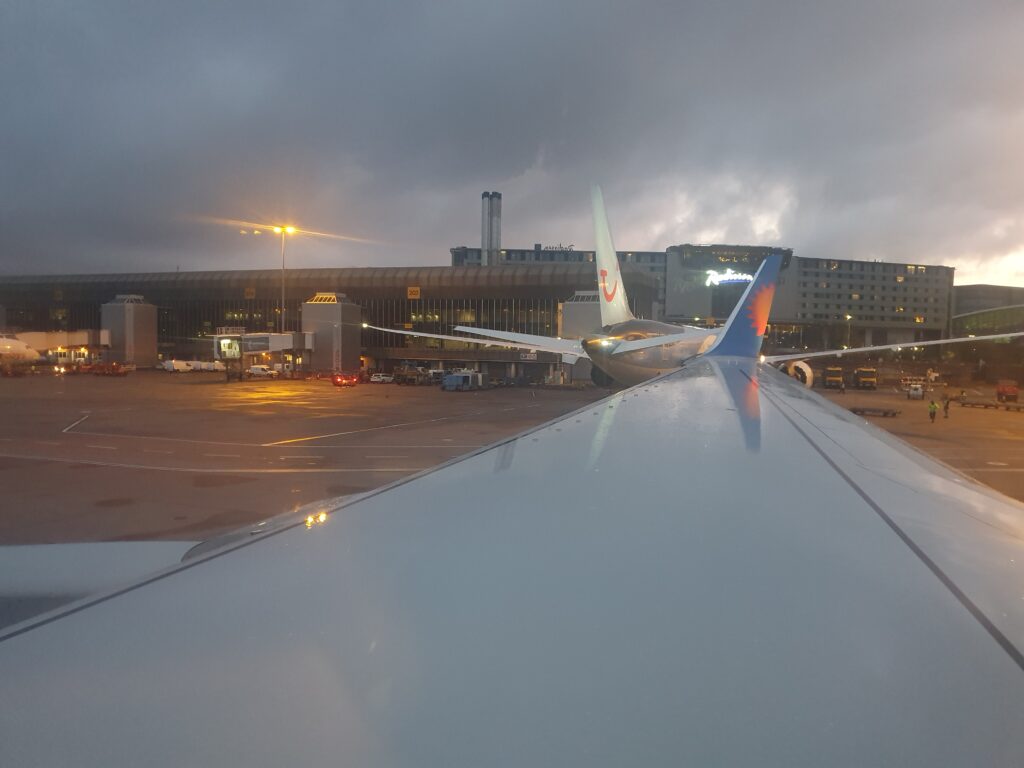
Passing Terminal 3 and Terminal 1, eventually, the aircraft reached the end of Runway 23R and held next to the Airport Pub. With one runway in use at that time of the morning, the Boeing was required to wait there for a few minutes for an Aer Lingus Airbus A320 to land, followed by a Gulf Air Boeing 787-9 Dreamliner sporting the airline’s retro colours. Once the Dreamliner had touched down on British soil, the Boeing taxied onto the runway and came to a short halt. At 0717, the two engines spooled up and produced a distinctive whine before rocketing down the runway in what seemed to be a rather powerful and sporty departure. Presumably being rather lightly loaded for the short hop to Switzerland, we soon rocketed upwards and made a steep climb into the dawn skies. Rocketing upwards over the fields of Cheshire, the aircraft banked resulting in a picturesque view of Manchester Airport before we turned onto a southerly heading. From Manchester, the aircraft voyaged southwards and passed the likes of Stoke-on-Trent, Wolverhampton and Birmingham, although unfortunately with clouds having rolled in below, nothing of the Midlands could be seen.
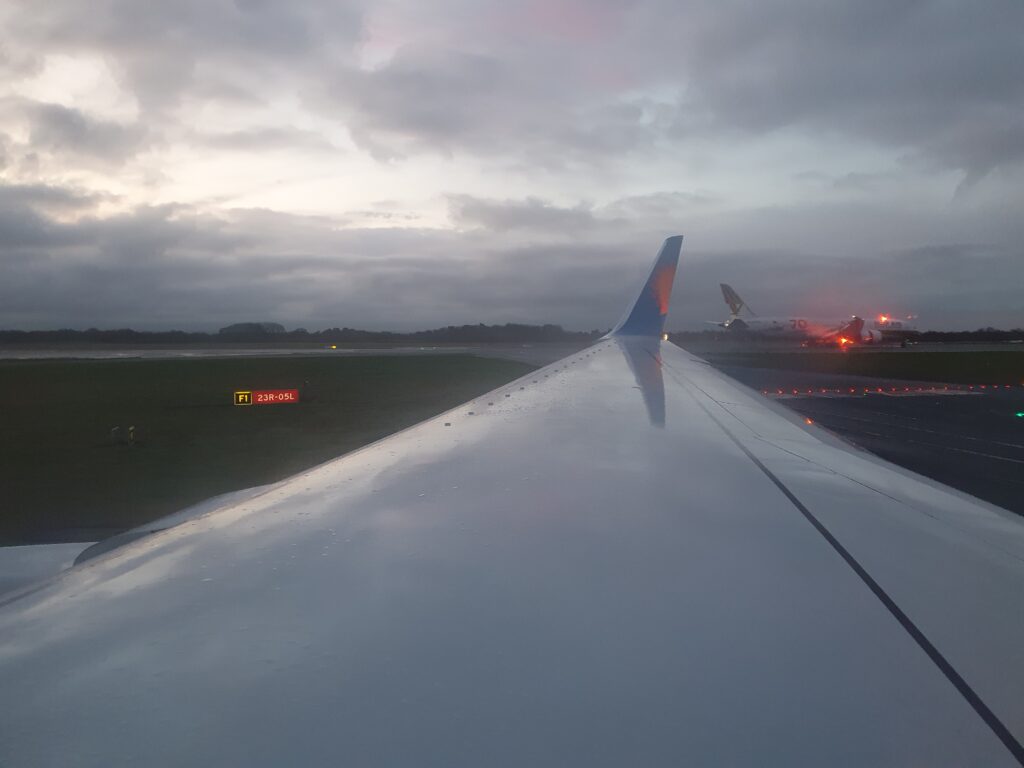
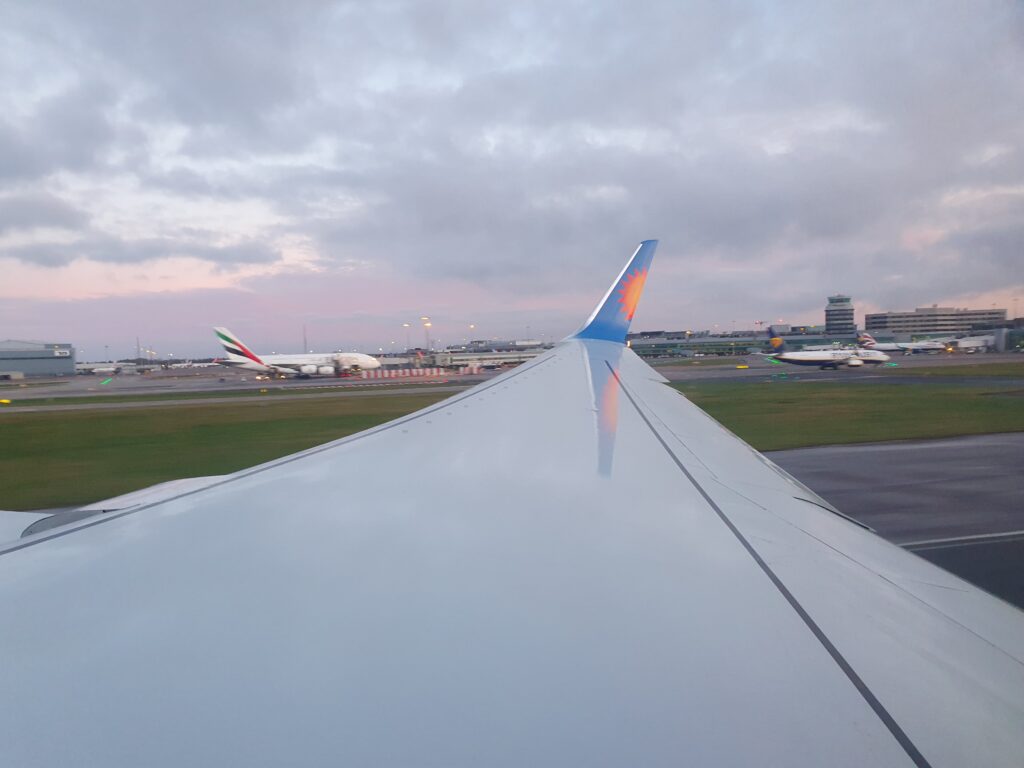
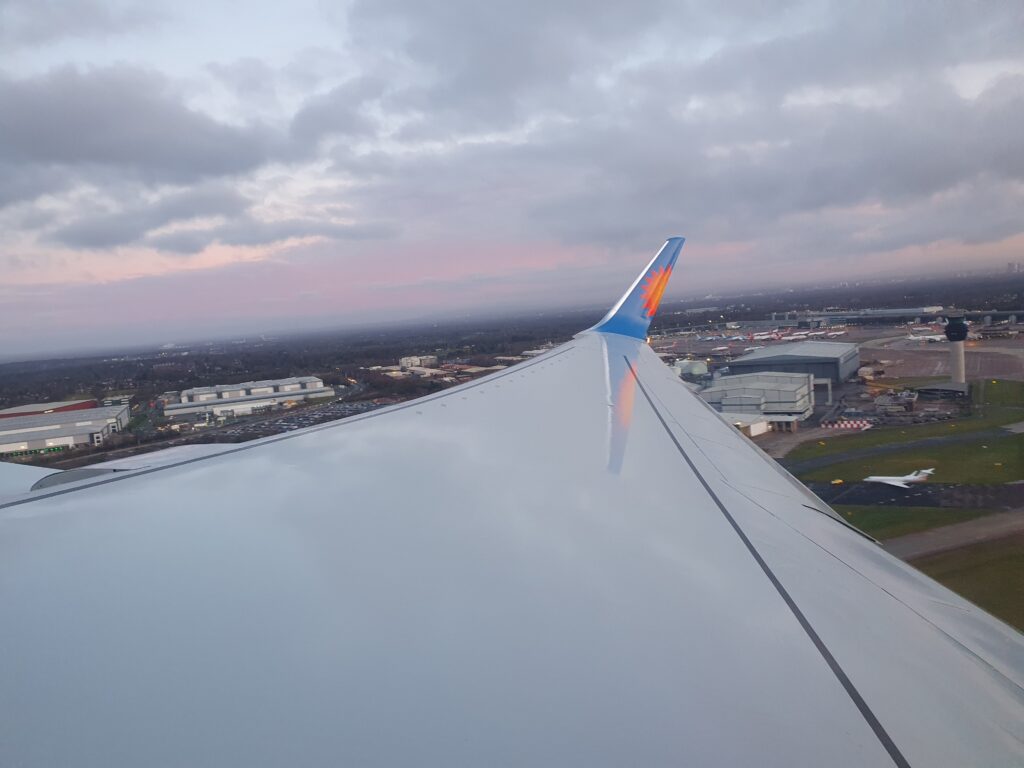
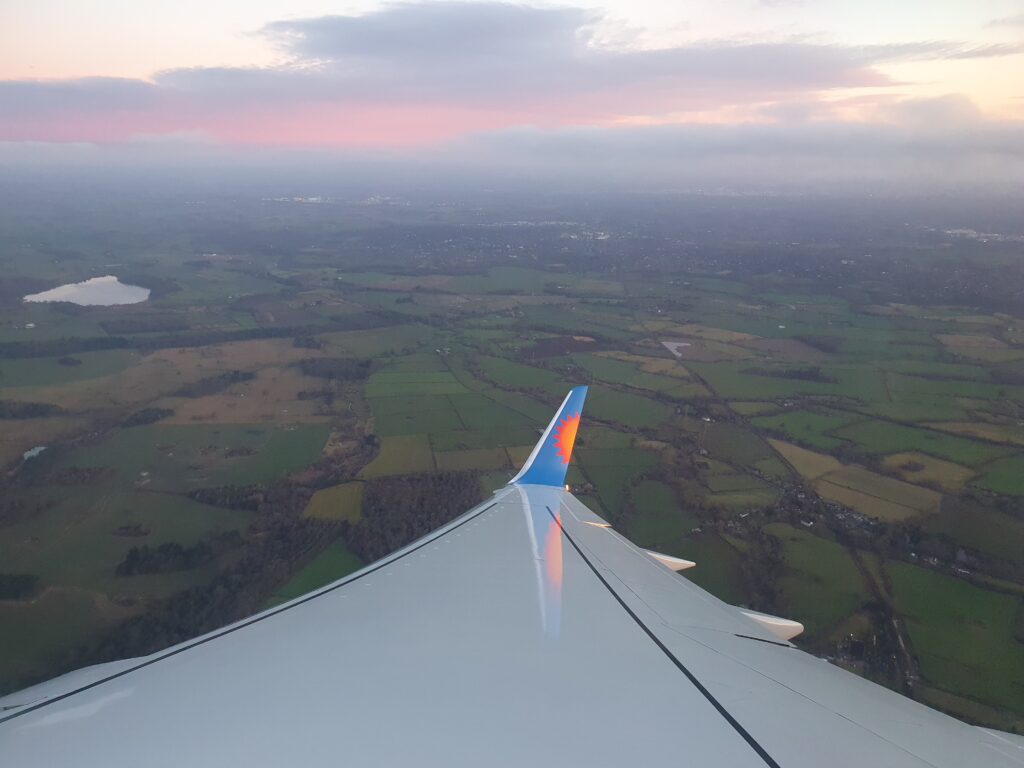

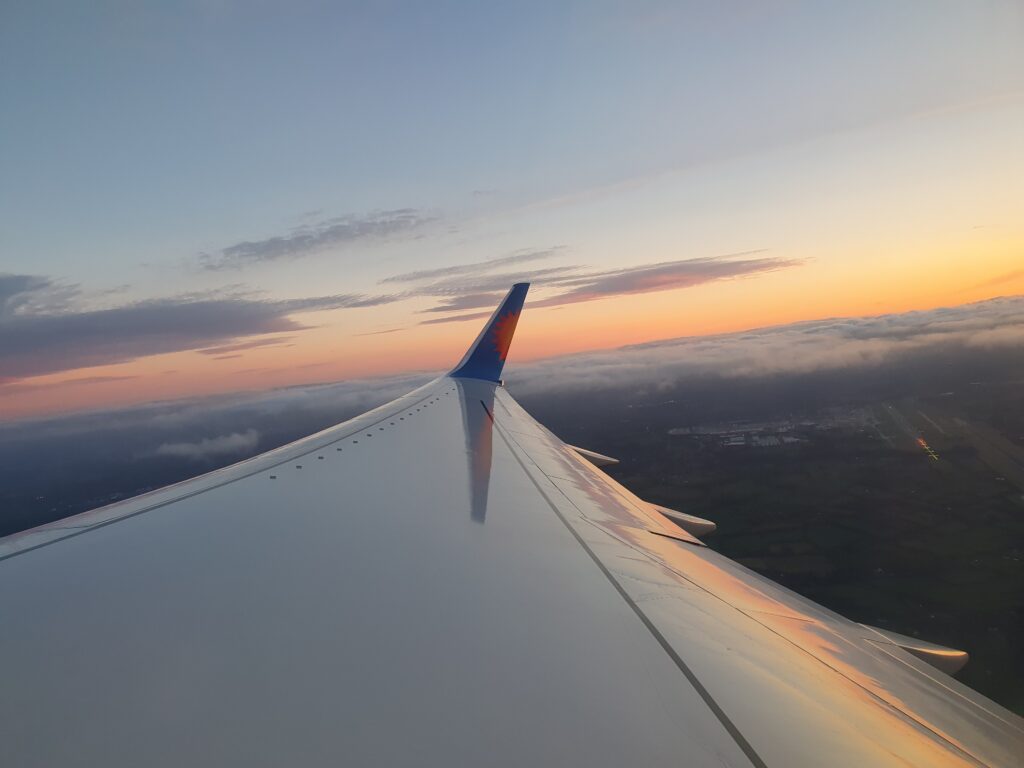
As we climbed, a pre-recorded announcement rang out advising passengers to remain seated with their seatbelts fastened before moving to advertise the onboard service. Wasting absolutely no time, once the crew were released from their seats, the trollies were rolled out into the aisle with the buy-on-board service commencing from both the front and rear of the aircraft. Whilst I had no intention of purchasing anything, I perused the MMmenu. I found this to contain the usual selection of drinks, light meals, sandwiches and sweets, with nothing out of the ordinary regarding both menu items and prices. For example, a sandwich or toastie would have set me back £4.90, a light meal £8.00 and a Starbucks instant coffee £3.20. Meanwhile, 330ml cans of beer and cider were sold for £5.60, with wines, spirits and canned cocktails priced at £6.00. Perhaps disappointingly for the crew, that morning few passengers seemed to express much interest in making any purchases and thus the crew were able to speed through the cabin.
By the time this first round of service concluded, the aircraft had levelled off at 35,000 feet and passed over the likes of Oxford, Reading and Guildford, and was now nearing the coastline of Southern England, crossing over this just to the east of the town of Worthing. Back inside the cabin, a pre-recorded announcement rang out that advertised the soon-to-commence inflight shopping service, which was followed by an announcement by one of the cabin crew members advertising the latest deals and encouraging passengers to buy items on the flight to Switzerland as these may not be available on their return journey. However, despite this warning, the crew failed to make many purchases and so they retreated to the galleys at the front and rear of the aircraft for a while.
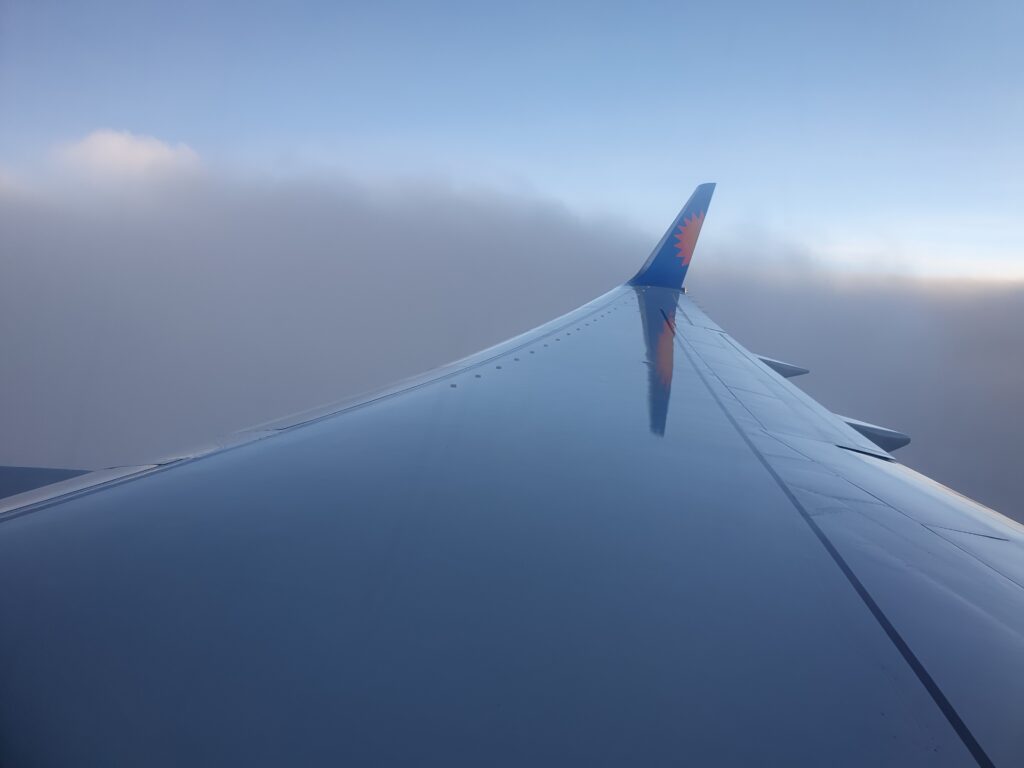
Returning to the route, the aircraft soon crossed the Channel and reached the shoreline of Normandy near the coastal city of Dieppe about seven minutes after leaving the UK behind. By this time, the skies outside had well and truly brightened and a new day had dawned, although clouds remained omnipresent below, so no views could be had as we sped inland and passed the city of Rouen, soon followed by Paris as we continued heading into the country’s heart. With free access to the aisle, I decided to go to the other lavatory between the middle and rear cabins which I found to be in a similar reasonable state to the one that I had visited before departure, albeit with a photo of several people jumping into the sea rather than a snowboarder in this one, being more representative of Jet2’s summer destinations.
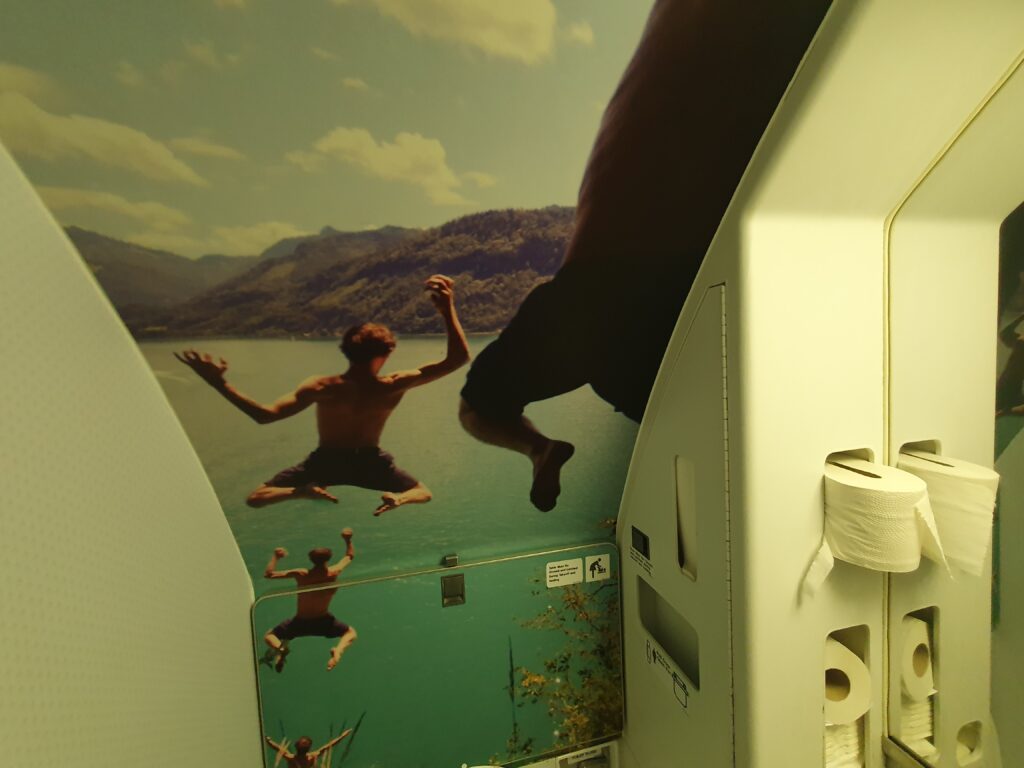
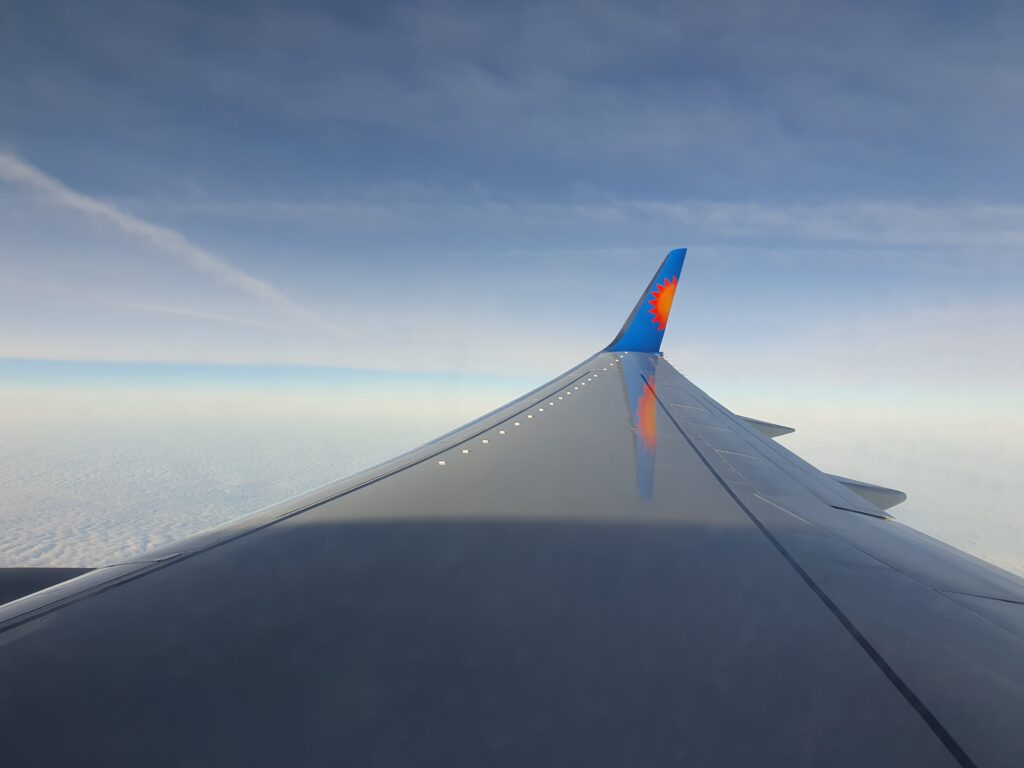
By the time I returned to my seat, the flight was entering its final third and the crew hit the aisle undertaking a shortened version of their buy-on-board service. This simply consisted of the crew passing through the cabin taking passengers’ orders for any food and drink items before delivering these to their seats. As the aircraft passed through the skies of France’s Bourgogne-Franche-Comté region, the Boeing could be felt commencing its journey back to earth and the Captain’s voice could be heard once again advising that we had commenced our descent into Geneva, offering an updated arrival time and advising that we would likely arrive on stand ahead of schedule.
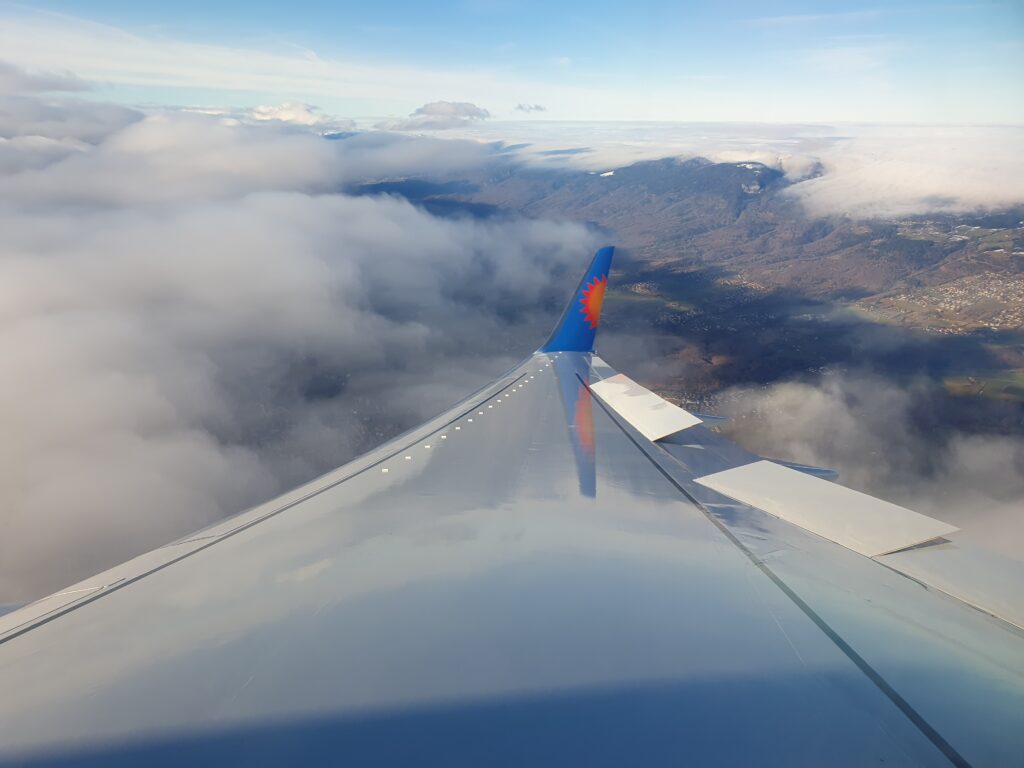
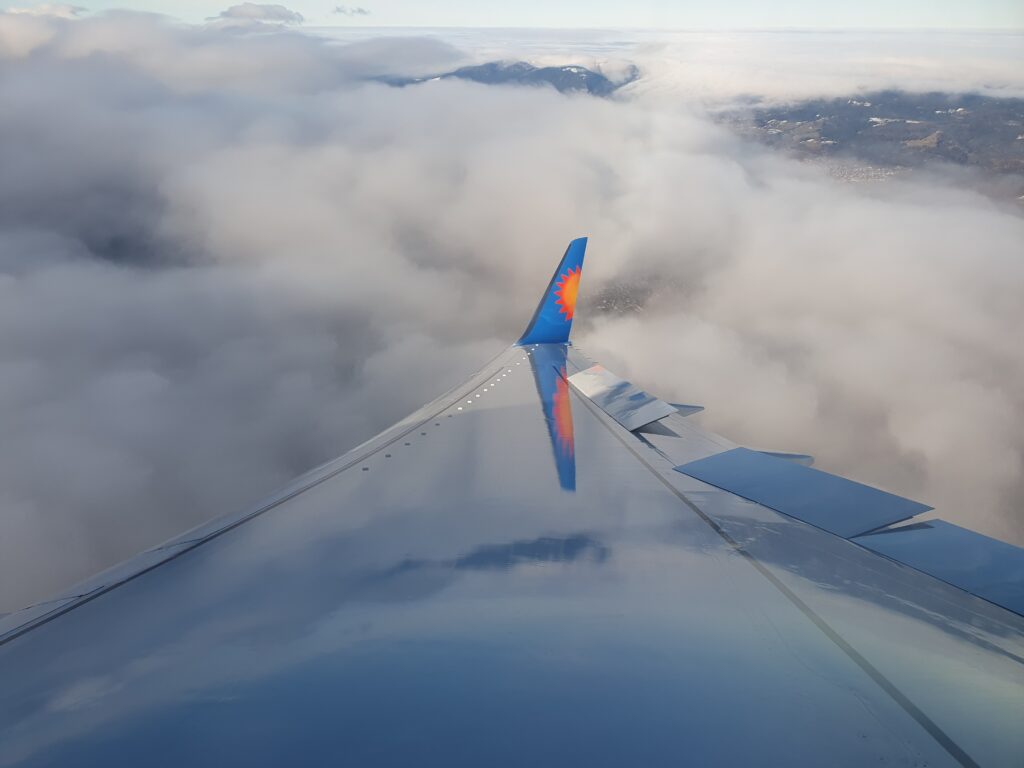
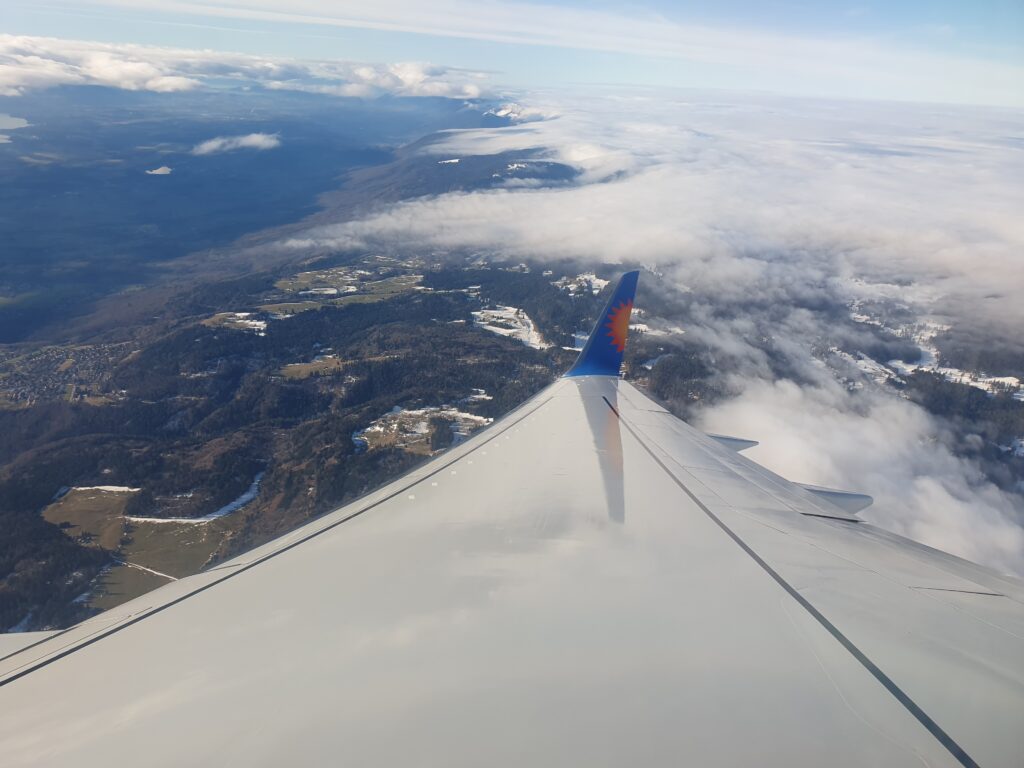
Once this announcement was made, several minutes passed before a pre-recorded announcement regarding our descent was played, followed by another by one of the flight attendants just before the seatbelt signs were re-illuminated. Once these signs had been switched back on, the crew took to the aisles ensuring that all was secure and in place for our arrival, however, with an obedient bunch of passengers onboard, they did not seem to have many issues in ensuring that everything was secure in preparation for our arrival.
Seeing as Geneva is located right on the border with France, the vast majority of the descent took place in French skies and soon, the aircraft passed through the clouds before the green scenery on the border between France and Switzerland appeared as our flaps and landing hear were lowered into position just before we passed over the shores of Lac Léman. Heading westwards along this lake, for the first time during the flight, the aircraft bounced around a little, although this turbulence did not last too long. Continuing along the lake, I caught sight of the towns that sit on its northern shoreline such as Prangins, Nyon, Crans, Founex and Mies before we made landfall near Versoix and entered the final minute or so of the flight.
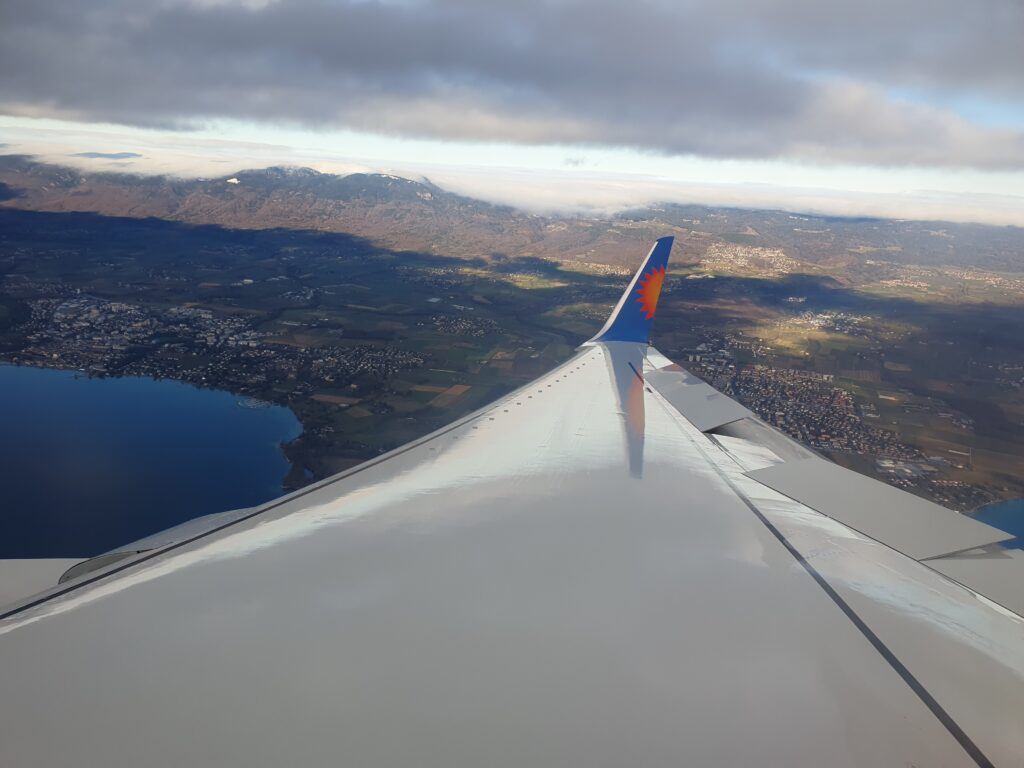
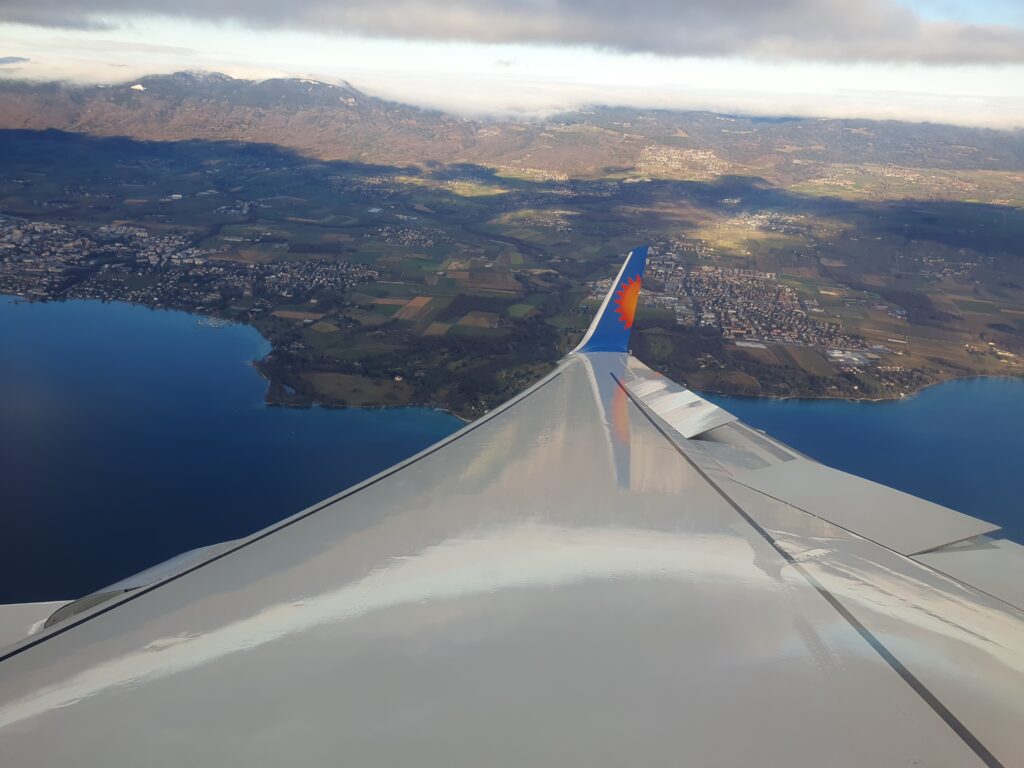
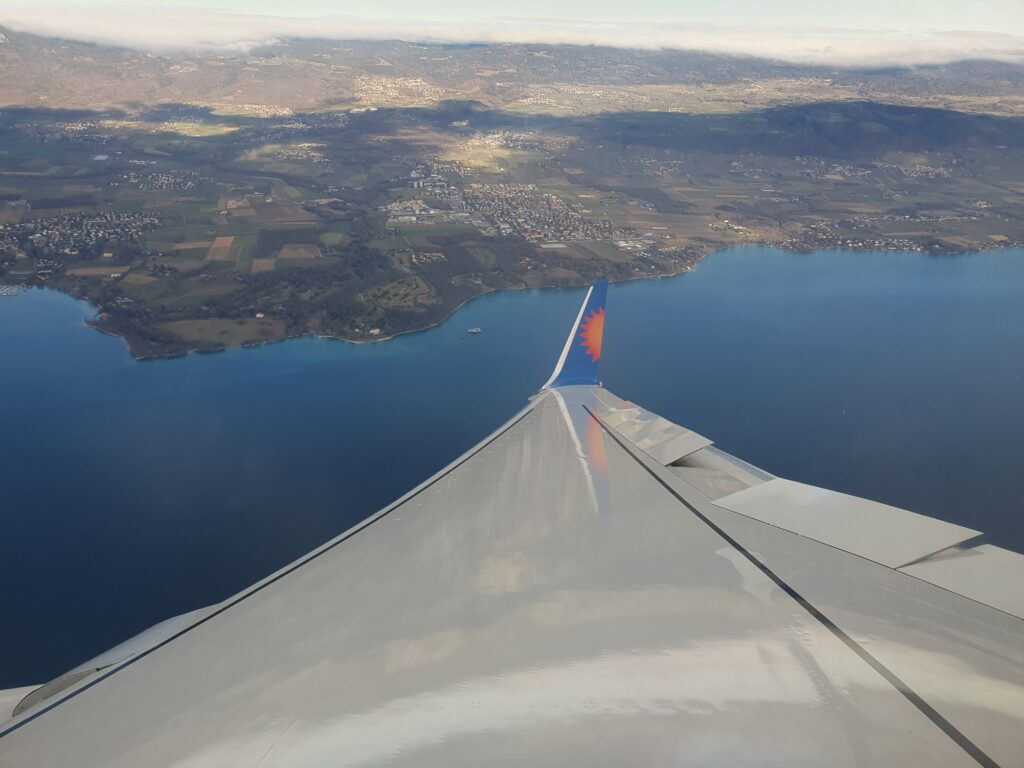
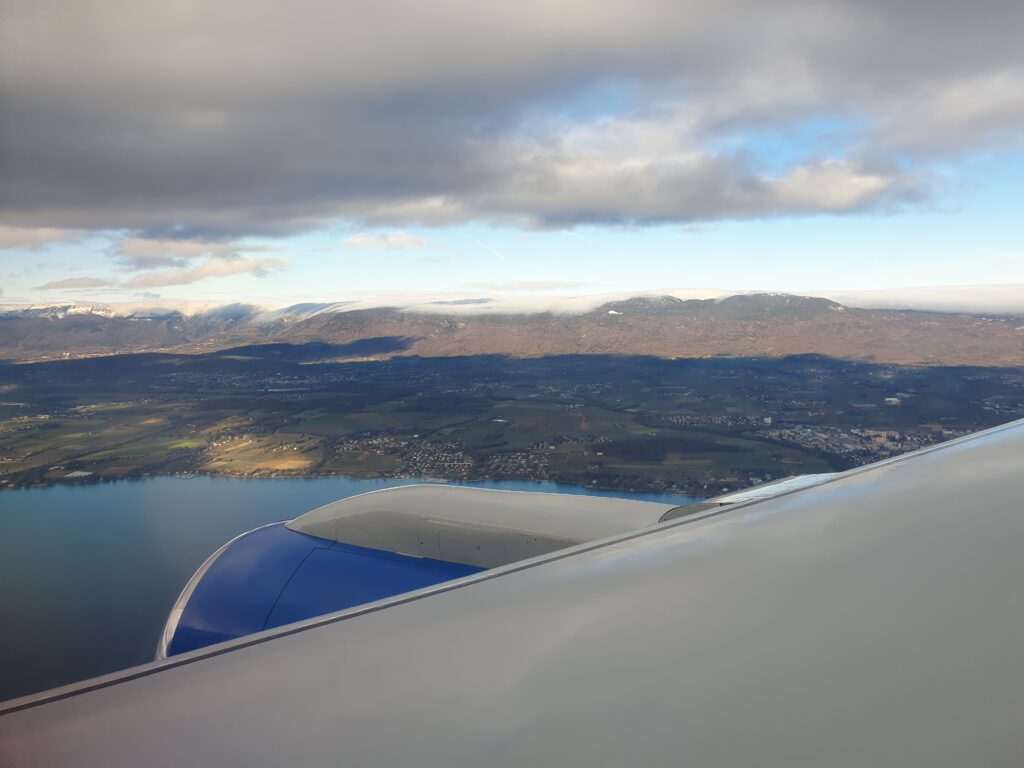
After an hour and twenty minutes in the skies of Europe, at 0937 local time, the Boeing sank over the perimeter fence and made a fairly soft touchdown on Runway 22. This was followed by what seemed to be some gentle braking before we vacated the runway to the left and commenced our journey to Stand 87. Inside the cabin, a welcome announcement was performed and passengers were advised to remain seated, with fortunately all obeying this instruction.
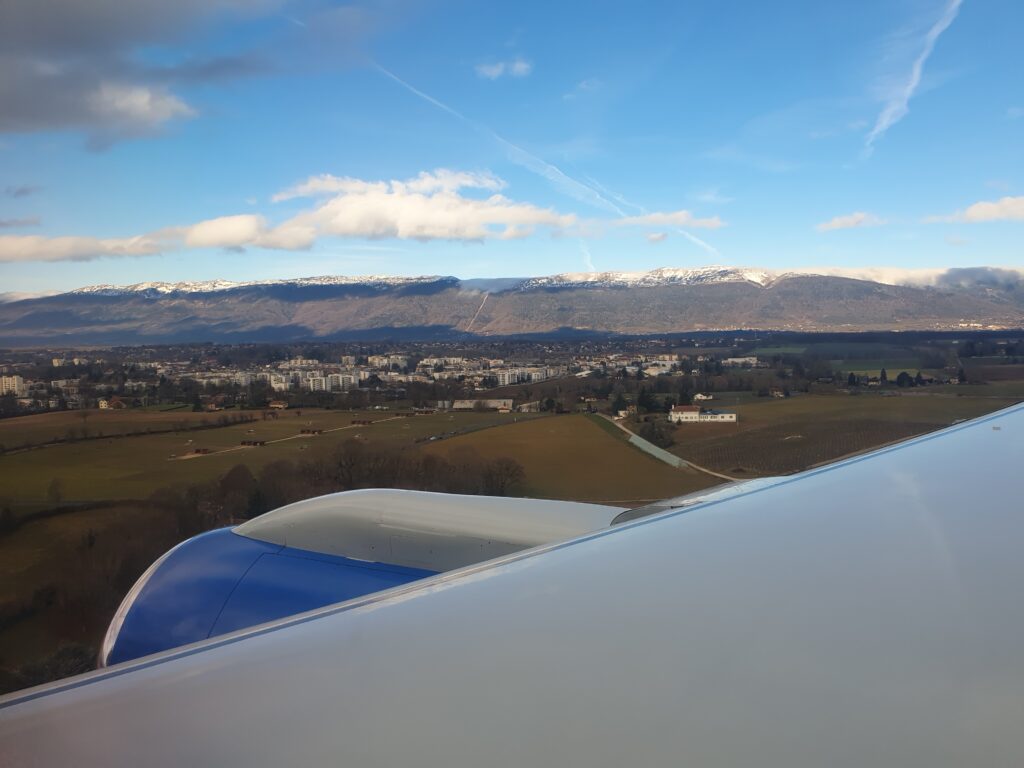
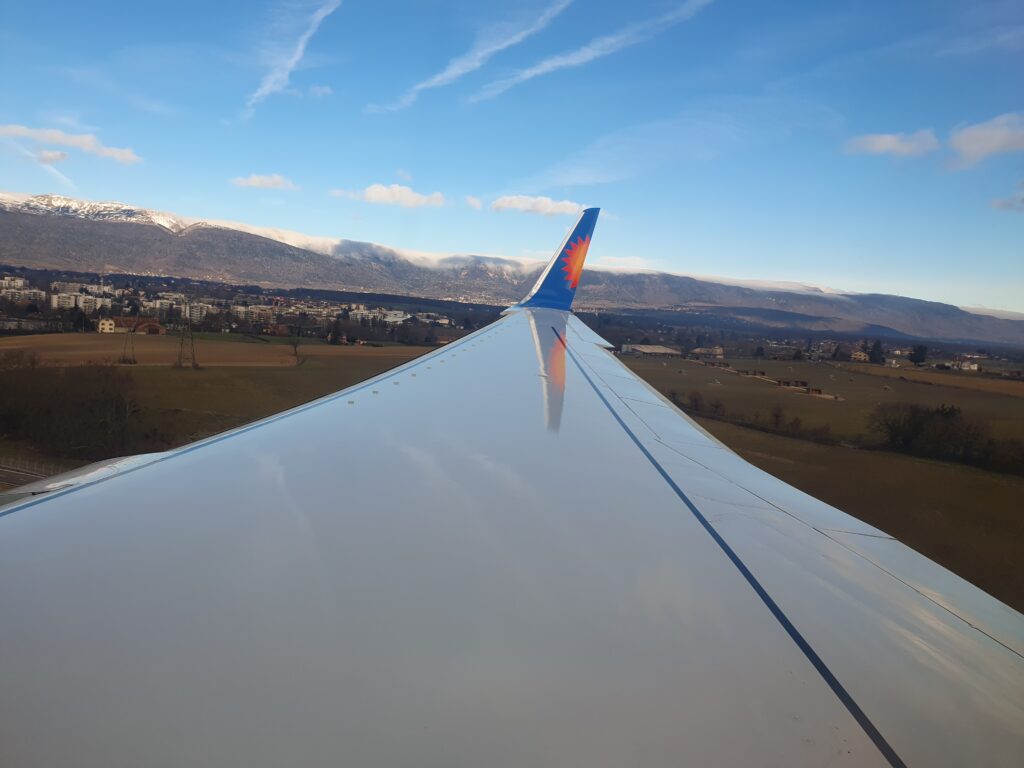

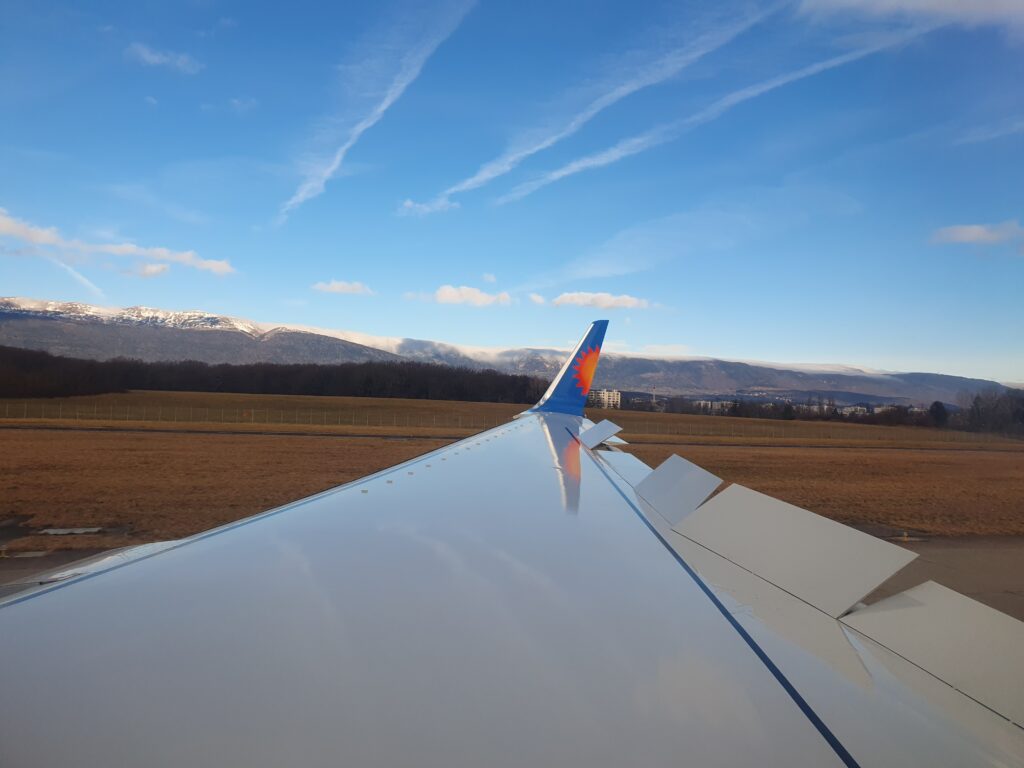
In Geneva, Jet2 operates at the airport’s winter-only terminal, Terminal 2. However, the set up for this terminal is rather strange. Located in a rather dated-looking building, this contains inbound immigration facilities, baggage carousels and check-in desks. However, this does feature departure gates, instead, passengers depart through gates in the main terminal, Terminal 1, and outbound passengers may either pass through security in Terminal 2 before being shuttled to Terminal 1 on an airside bus, or pass through security at Terminal 1. Four minutes after landing, the Boeing came to a halt near Terminal 2, although not close enough to be allowed to walk and thus once the engines had spooled down, some waiting was required until a fleet of Swissport buses appeared at the airport.
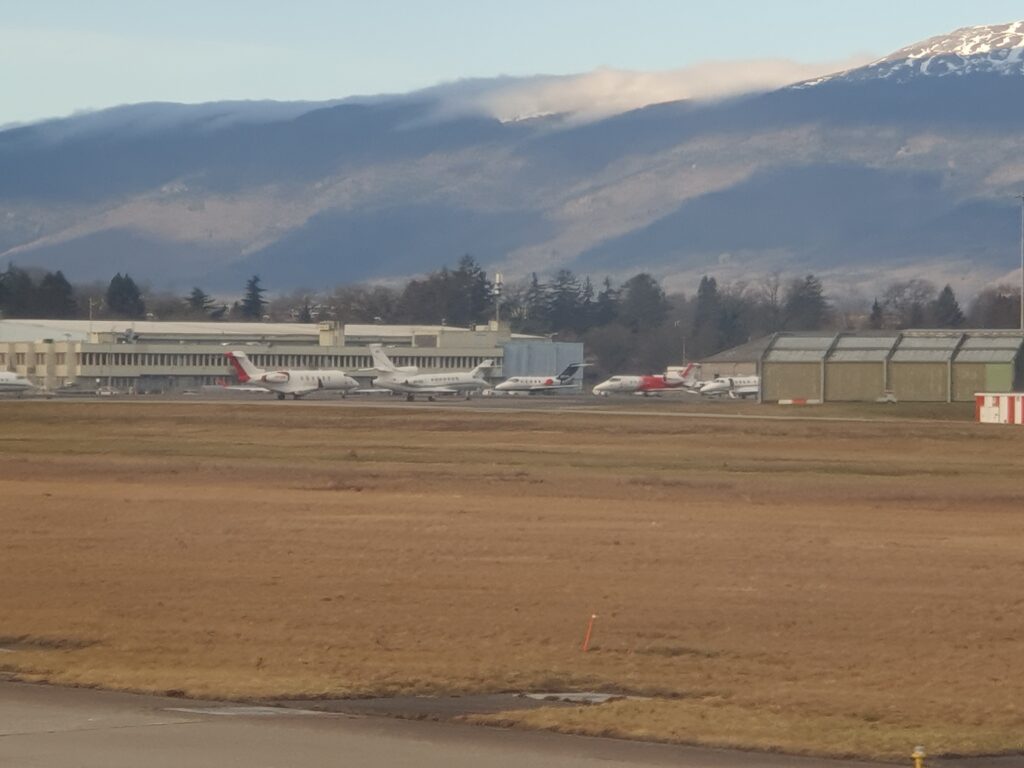
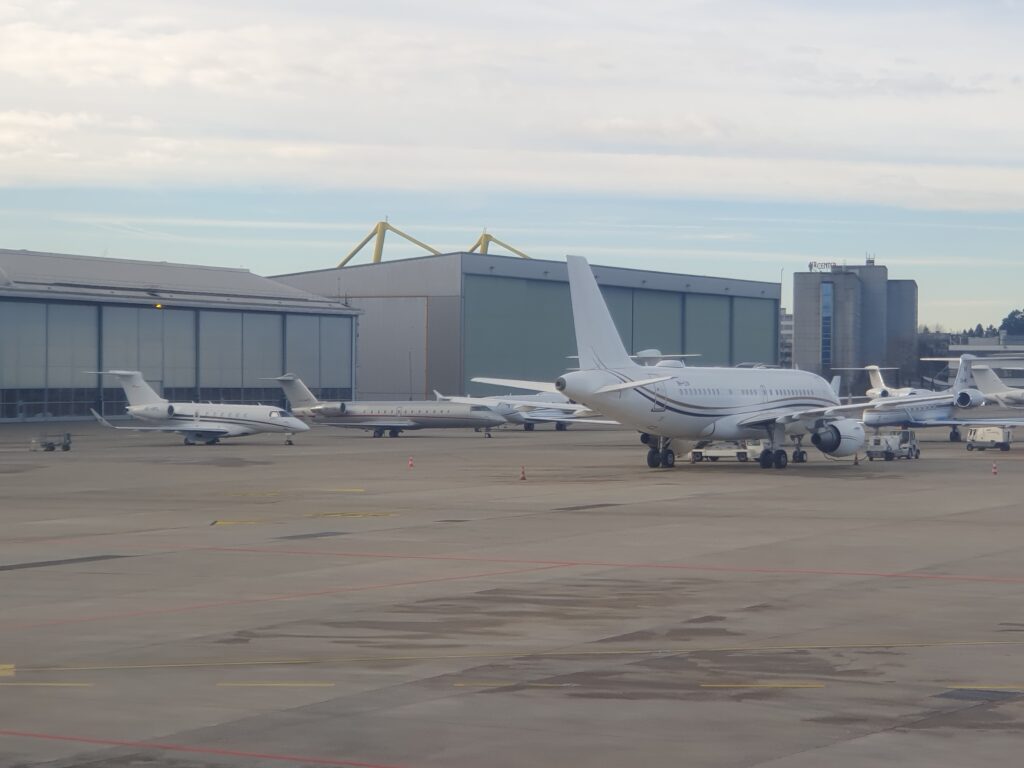
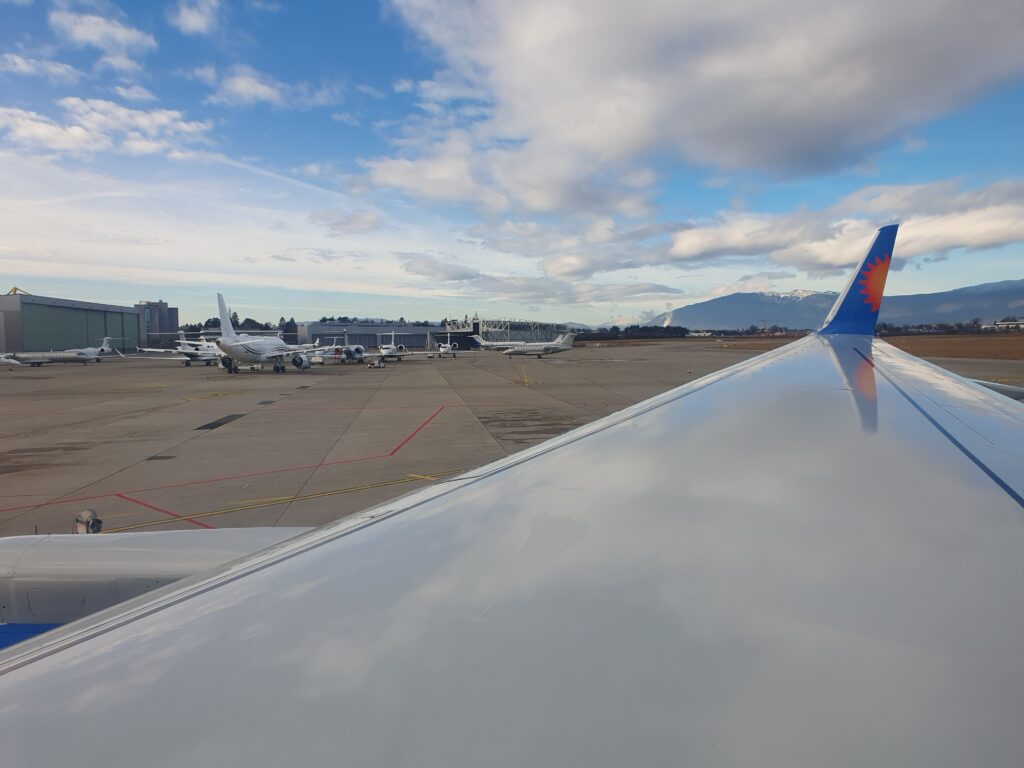
After a few minutes, the doors were opened and disembarkation commenced. Once I had stood up, I made my way to the rear of the aircraft where I thanked two of the friendly flight attendants before heading out into the pleasantly warm and sunny Swiss air. After skirting around the Boeing’s port wing, I boarded the bus and was soon whisked away to the terminal. Unfortunately, once there, with just two passport control counters open, some queuing was required before I was stamped into Switzerland and the Schengen Area. Despite this wait, by the time I made it to the baggage collection hall there was still no sign of luggage and some more waiting was required before this finally appeared. On a side note, with Jet2 being a major winter destination for Jet2, the airline bases plenty of ground staff at the airport and several agents could be seen lingering around this hall ready to answer passengers’ questions. Eventually, my suitcase appeared and I picked this up and made my way out ready to commence my stay in Geneva.
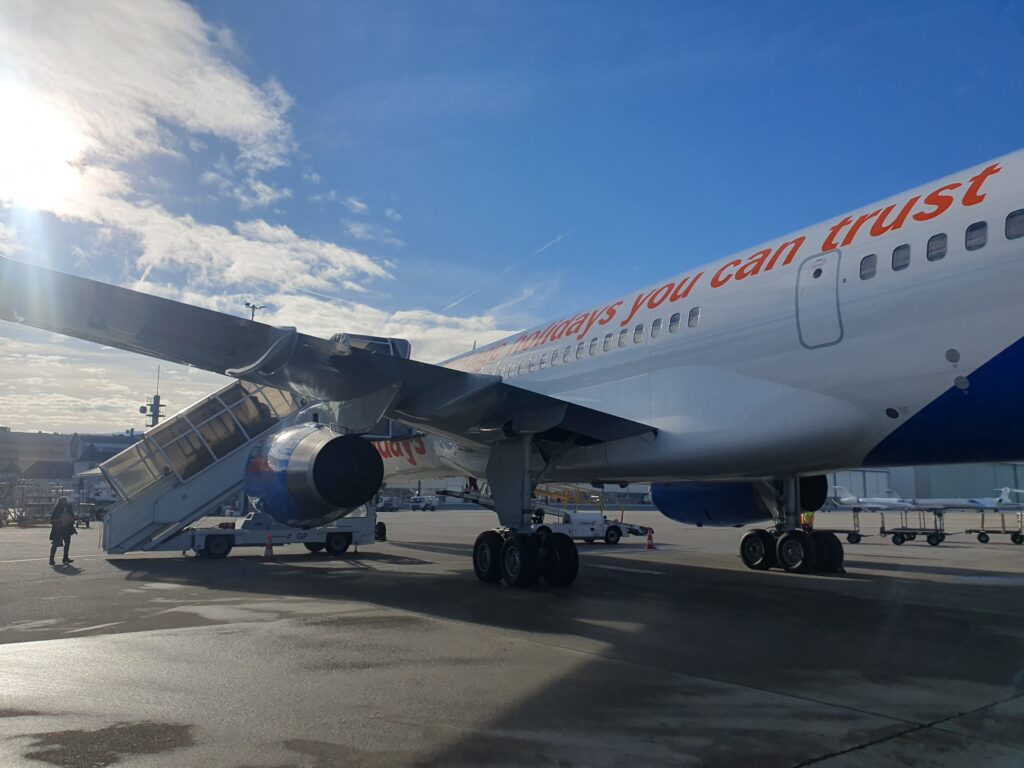
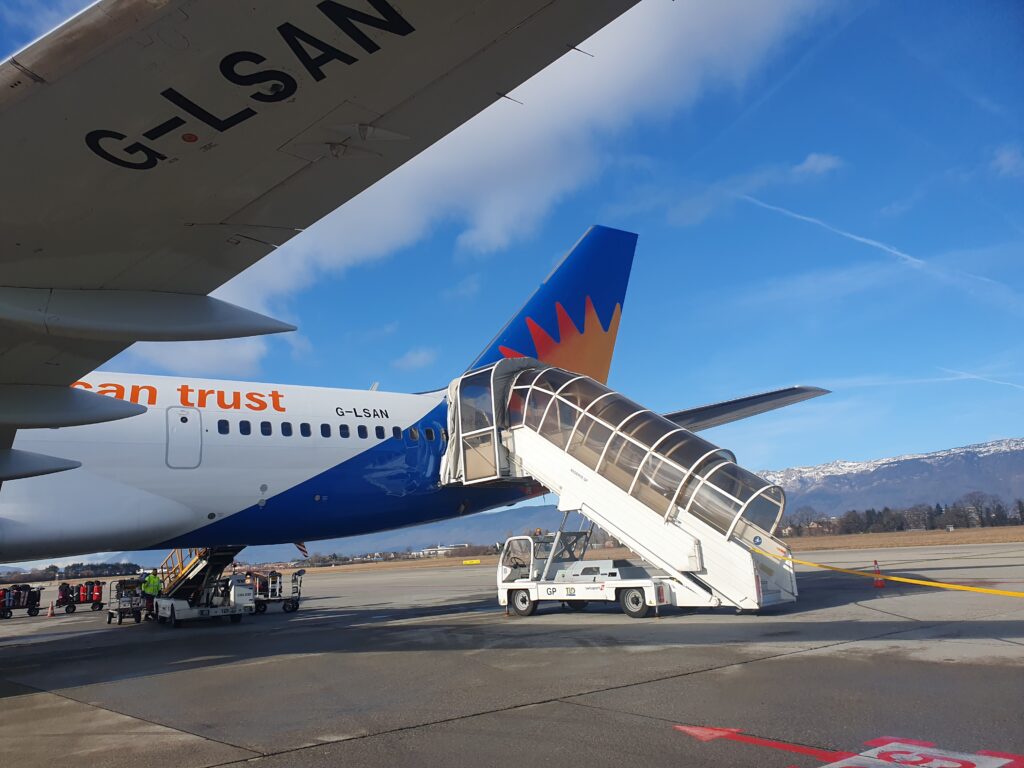
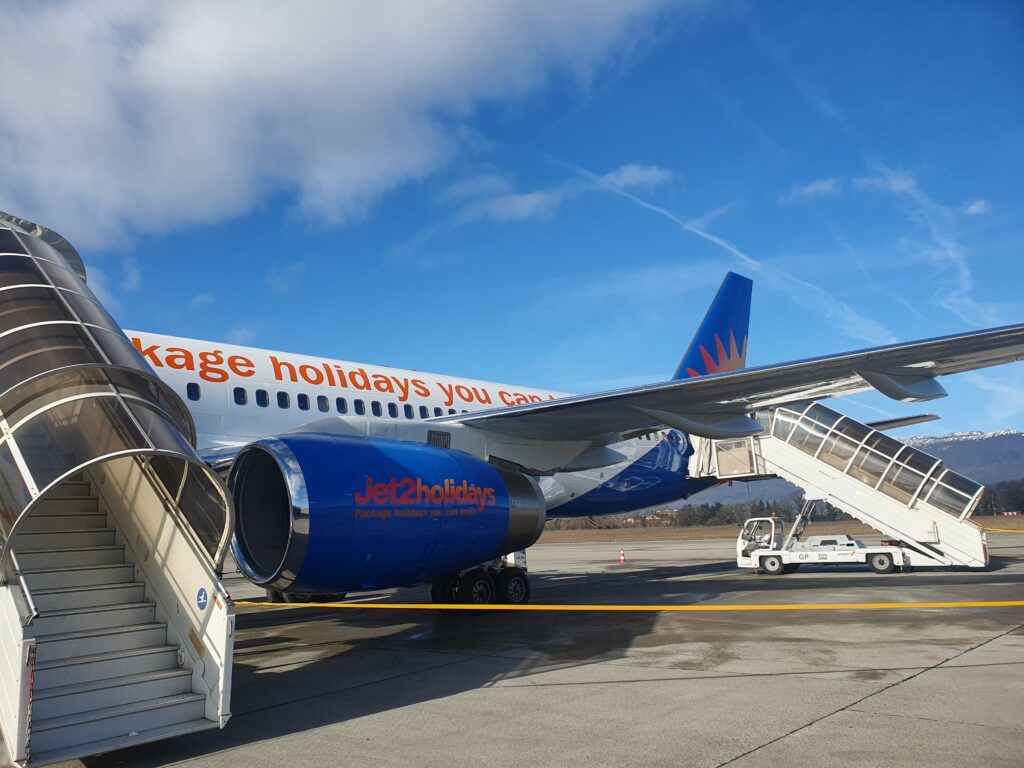
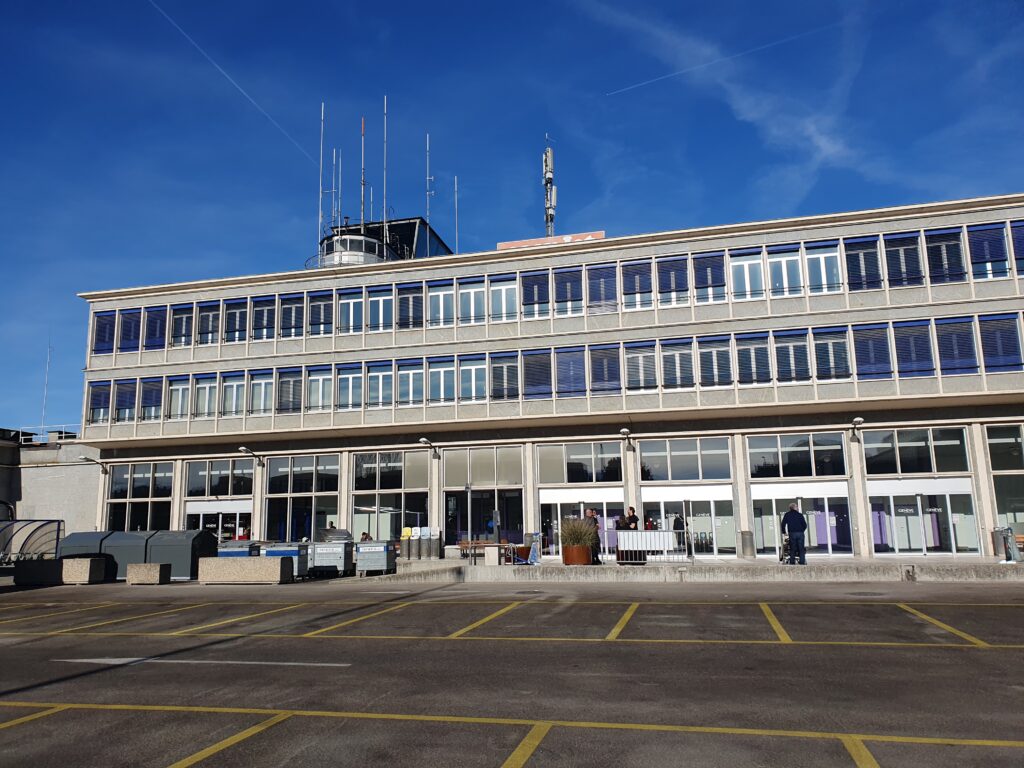
Summary
That morning, my Jet2 experience was very good. Not only was I pleased to catch a ride on the increasingly elusive Boeing 757, but the aircraft was clean and in tip-top condition, both the ground staff and cabin crew were very pleasant and friendly, and I arrived in Geneva in one piece and ahead of schedule. Needless to say, I would happily fly with Jet2 in the future!

